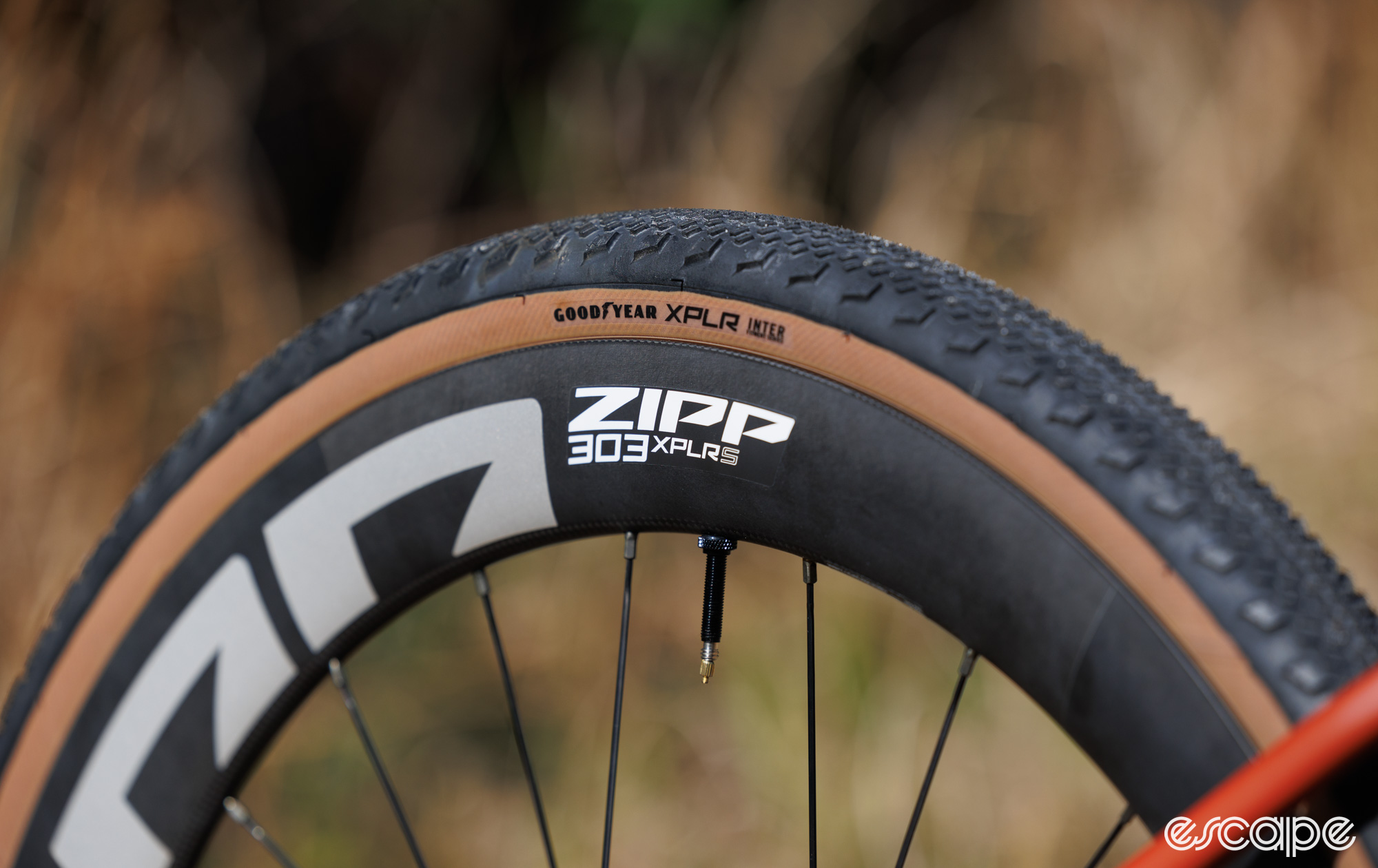A sibling to SRAM, wheel and component brand Zipp has revealed a handful of gravel-racing-focused products to match the new Red AXS XPLR groupset today.
Most notable of these new XPLR-branded components are the 303 XPLR SW and 303 XPLR S aero-focussed gravel wheelsets, each offering an enormous 32 mm internal rim width with a 40 mm external dimension. Such mind-bogglingly wide and hookless (TSS) rims come with obvious tyre fitment limitations, and so Zipp has expanded on its partnership with Goodyear to provide suitable “Fitment Series” tyres.
Additionally and just as we recently saw with the release of SRAM Red AXS on the road and its matching Zipp SL80 Race handlebar, the company has produced an equivalent handlebar match for gravel.
I’ve been riding the more affordable of the two new 303 XPLR wheelsets, along with the wider tyre option, and the new handlebar. Within you’ll find full details of the new products and my test findings.
Zipp 303 XPLR S aero gravel wheelset
Good stuff: Aero makes sense for fast gravel, impressive cross-wind stability, ultra-efficient on champagne-type gravel, easy-enough tyre install and inflation, decent weights considering the oversized dimensions, and competitive pricing.
Bad stuff: Increased compatibility limitations in an already confused market, limited approved tyre options, ride becomes sensitive to tyre pressure, thin rim sidewalls are exposed to knocks, wide rim squares the tyre profile, clearance is a concern on some bikes, squared tyre profile can do weird things to handling.
What in the width?
No that wasn’t a typo. Zipp’s new gravel race wheels do in fact have a 32 mm internal width. That’s wider than the current status quo in mountain biking (30 mm), and it’s wide enough that the company’s pre-existing Zipp 303 Firecrest wheels (25 mm internal) slot within the rim bed of these new hoops. According to Zipp, the brand landed on that relatively extreme width for two reasons: one being aero, and the other being vibration reduction.
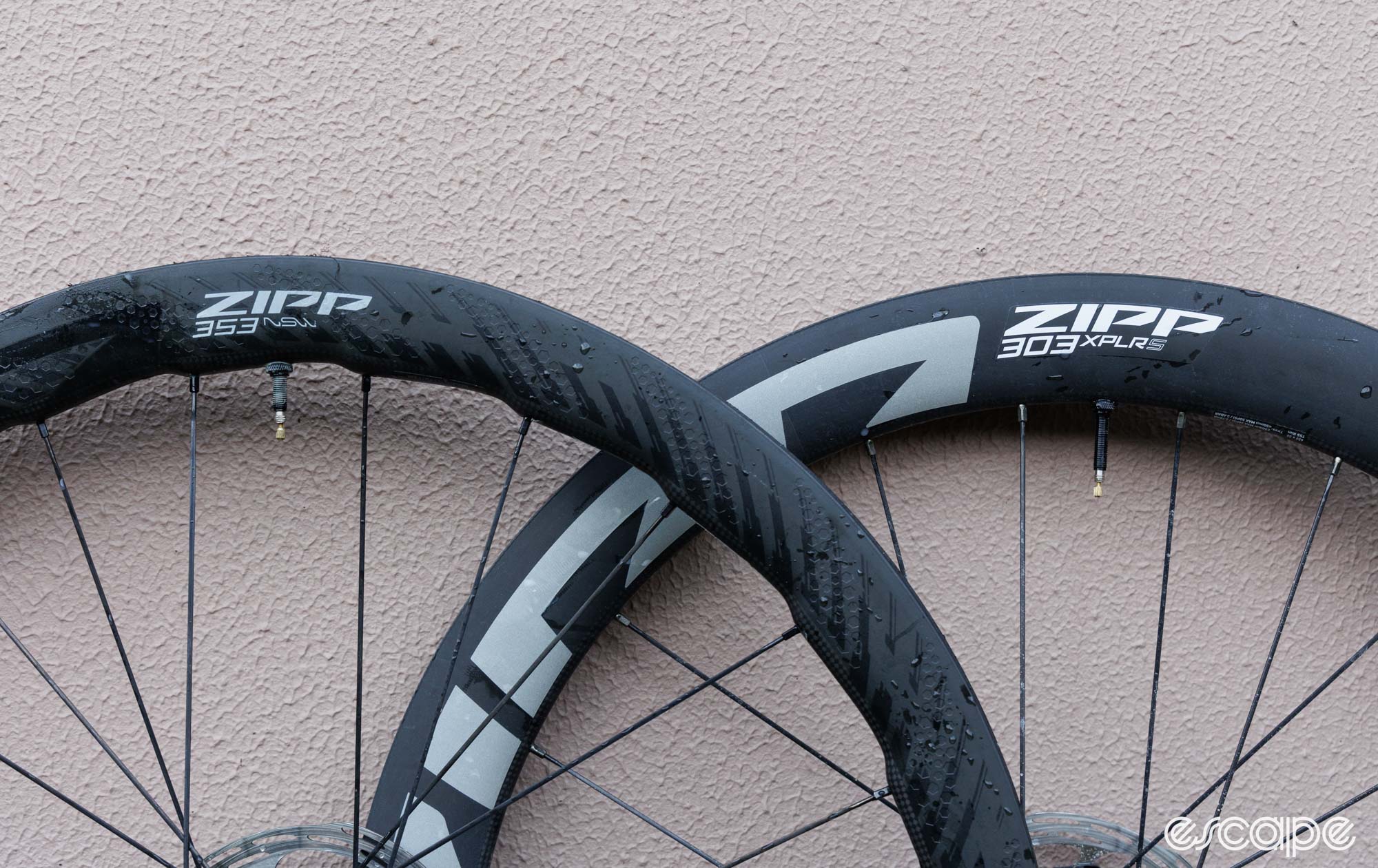

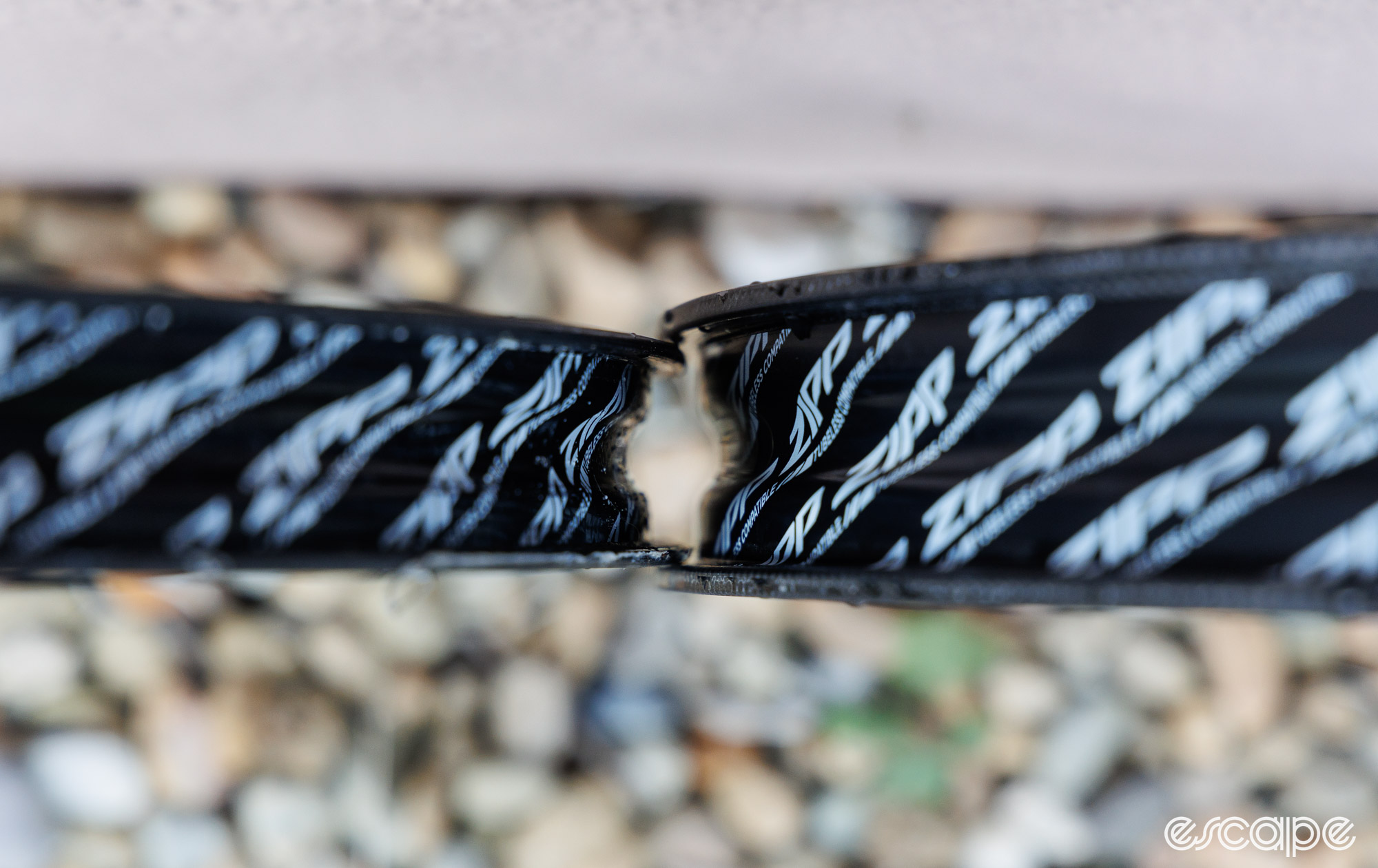

As average speeds in gravel races continue to increase, of course, so does interest in aero optimisation. We’ve seen the likes of 3T, Hunt, Parcour, DT Swiss, and Lightbicycle all claiming to provide a recipe for going faster with gravel-width tyres. Zipp’s efforts are arguably the most extreme example we’ve seen to date, with a significantly wider internal width than the aero options before it. Zipp combines that with a 40 mm external width, and a 54 mm rim depth (56 mm as measured) shared across both front and rear wheels.
When matched with a 40-45 mm tyre, the wide rim aims to remove much of the usual light-bulb-like shape from running a wide tyre with a narrower rim. Instead, there’s a relatively uniform and airfoil-like profile that aims to keep the air better attached and flowing more smoothly. Of course, Zipp claims its multiple trips to the wind tunnel show that it’s faster, saving approximately 5W (at 45km/ph) compared to a competitor’s gravel race wheel, but names are not named, and so I say meh to that. Still, it’s useful to know that Zipp state the wheel is fastest when paired with a tyre in the 40-45 mm range, while the brand still claims it to offer some aero advantage with even wider tyres.
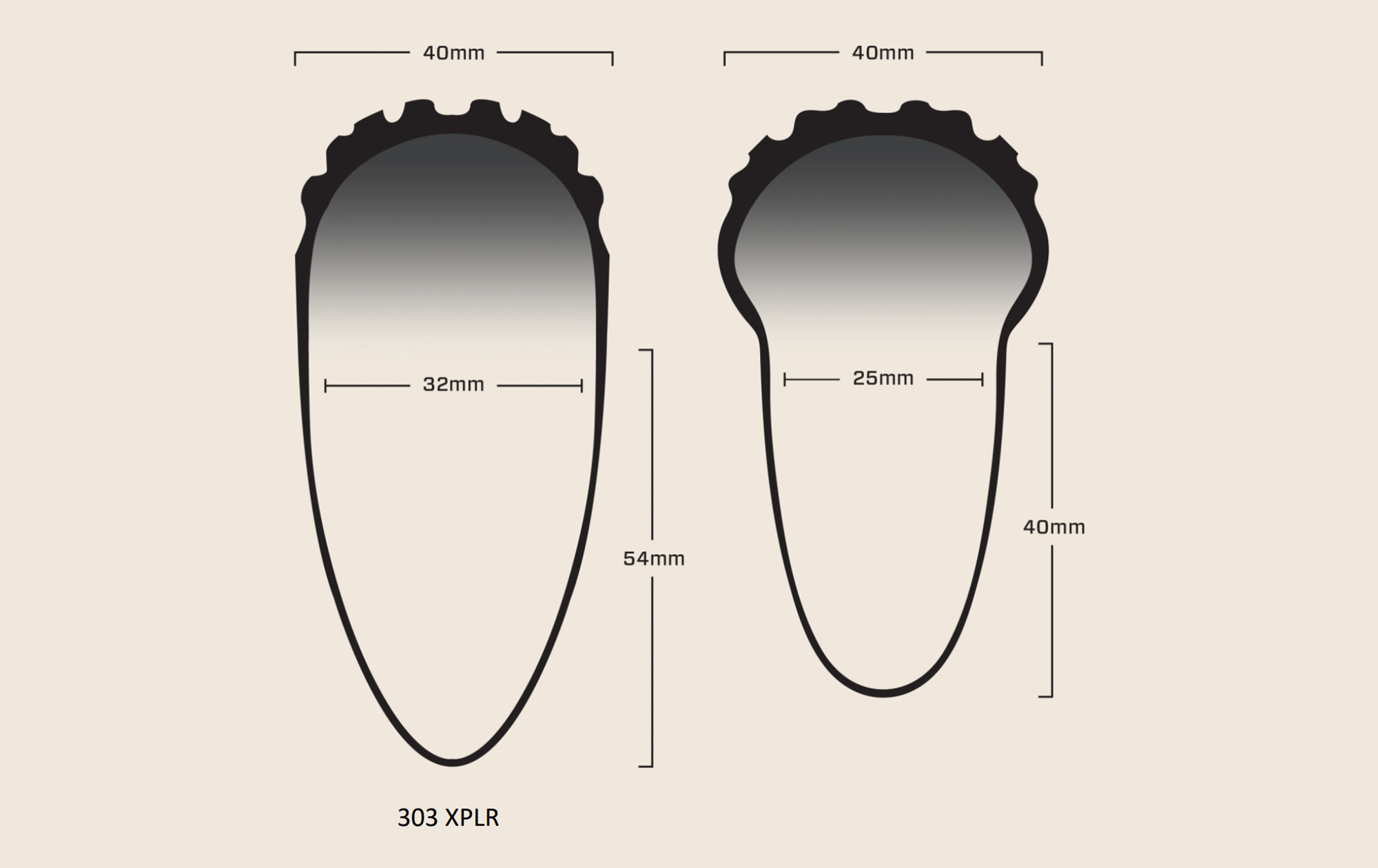

According to Zipp, far greater speed gains can be had in reducing rolling resistance and vibrational losses. While certainly not alone, the American brand’s testing has shown that lower pressures are always faster on rough surfaces until the point it negatively impacts bike handling. However, merely dropping pressures on existing rim widths tends to quickly introduce tyre sidewall instability and increases the risk of pinch flats. A wider and/or higher volume tyre is the answer to dropping pressures, and it’s why we’ve seen a trend amongst elite gravel racers to pick the widest tyre their gravel bikes allow.
From Zipp’s point of view, having such a wide rim means more air volume and that the tyre sidewalls are more directly supported, which in turn allows pressures to be safely reduced to well below 30 psi. Zipp’s rim design also borrows from many mountain bike rims, where a wide (4 mm) and blunt rim edge reduces the risk of pinch flats in the event the tyre bottoms out. You can bet I’ll come back to this topic.
There are two price point options to the new 303 XPLR range each with the same rim dimensions, 24 spokes on each wheel, and the company’s generous warranty program that covers in-ride damage. The flagship 303 XPLR SW (US$2,1000 / €1,800 / AU$3,150) offers a higher-end carbon lay-up, features Zipp’s signature texturing on the exterior of the rim, and has Zipp’s six-pawl ZR1 hub (with increased sealing) laced with Sapim CX-Ray bladed spokes. Zipp offers compatible freehubs to suit all major drivetrain options, including Microspline for Shimano GRX 1×12-speed and N3W for Campagnolo Ekar. All told, these wheels carry a claimed weight of 1,496 g, including rim tape and tubeless valves.
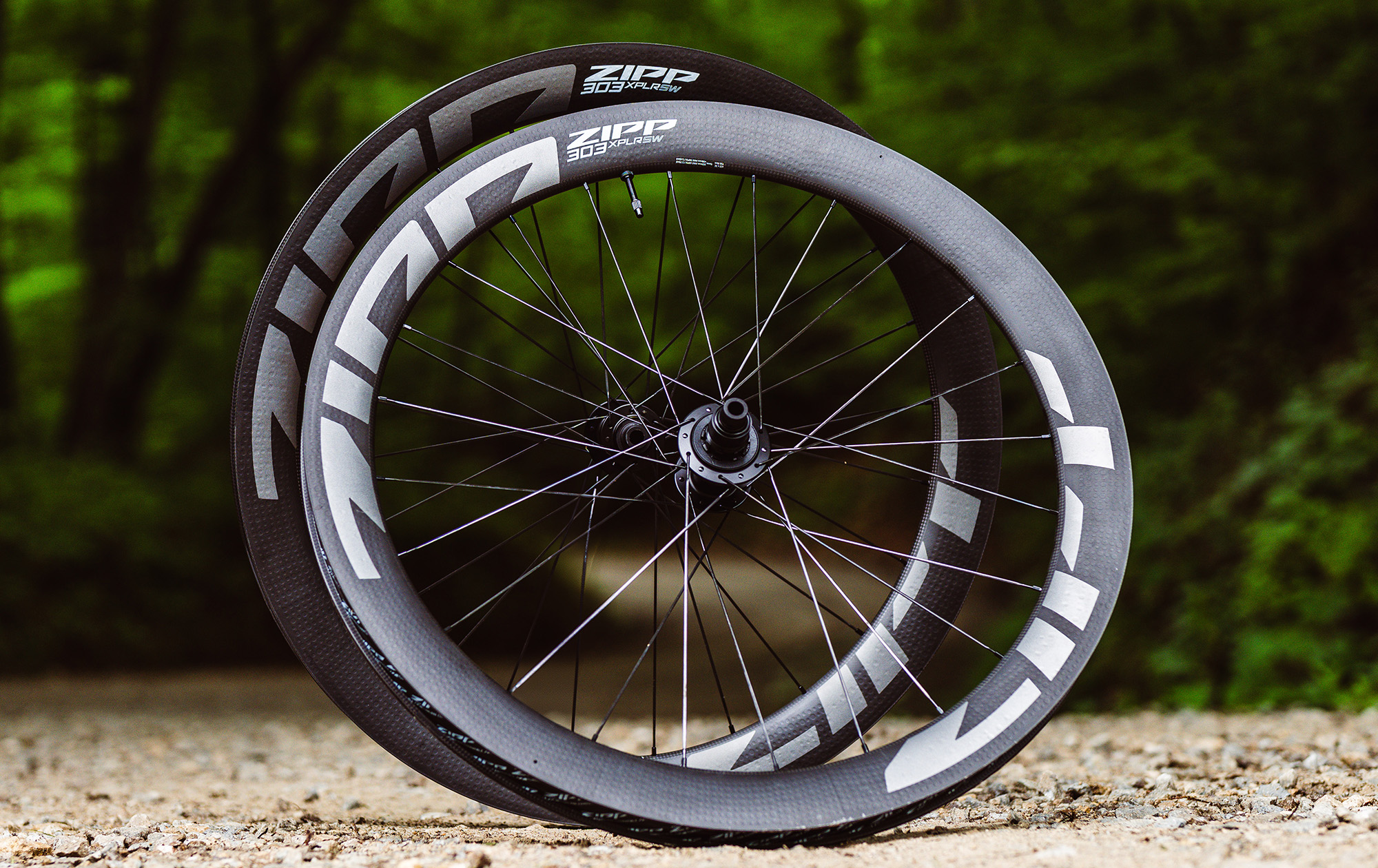

Then there’s the more affordable 303 XPLR S that I’ve been testing. Priced at US$1,400 / €1,200 / AU$2,150, these wheels feature a more basic carbon fibre layup without the fancy textured details on the exterior. Laced in place with cheaper/thicker/heavier Sapim CX-Sprint bladed spokes, the hubs are Zipp’s simpler three-pawl 76/176 DB models, with just SRAM XDR and Shimano HG freehubs are available to suit. Zipp claims a pair of these to weigh 1,642 g, with my test pair coming in at 1,623 g (XDR freehub, including tubeless rim tape and valves).
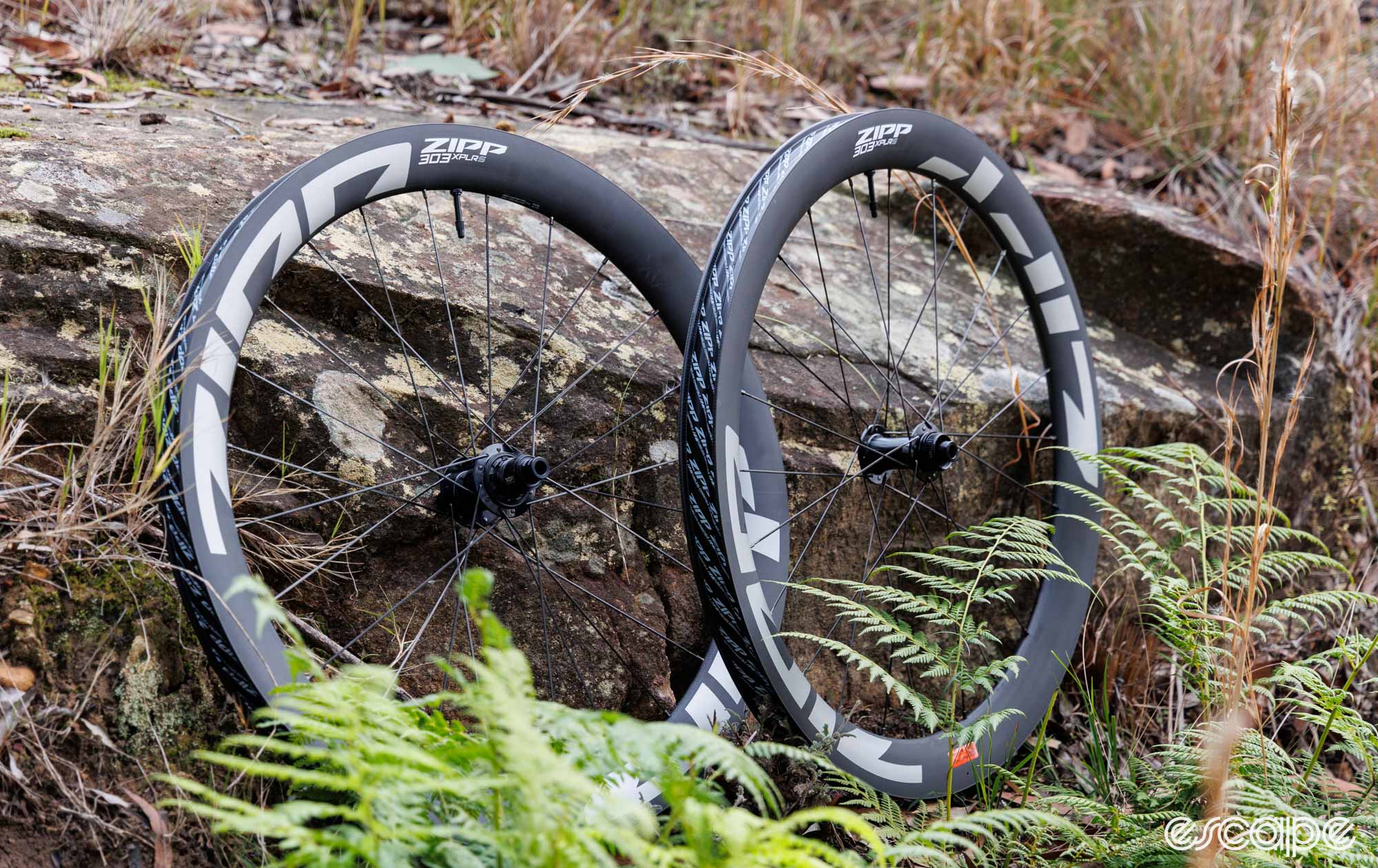

Tyre compatibility
Going 32 mm wide on a hookless rim designed for 40 mm+ tyres breaks new ground and, therefore, introduces a long list of caveats and compatibility limitations. If you thought the saga of hookless compatibility was beginning to iron itself out, then sorry to say, the mess has been unZipped and spread all over the floor.
The new 303 XPLR rims do meet ISO Tubeless Straight Side (TSS, aka, hookless) standards for a 622 x 32 mm rim (622 mm being the Bead Seat Diameter of a 700c wheel). However, for a rim this wide, the ISO standard calls for tyres between the widths of 58-84 mm. By contrast, Zipp’s recommended 40 mm or larger tyre widths fall obviously short of the existing (and relatively new) standard. Instead, Zipp openly states it’s not conforming to ISO tyre fitment recommendations and therefore has its own strict and limited list of approved tyres.
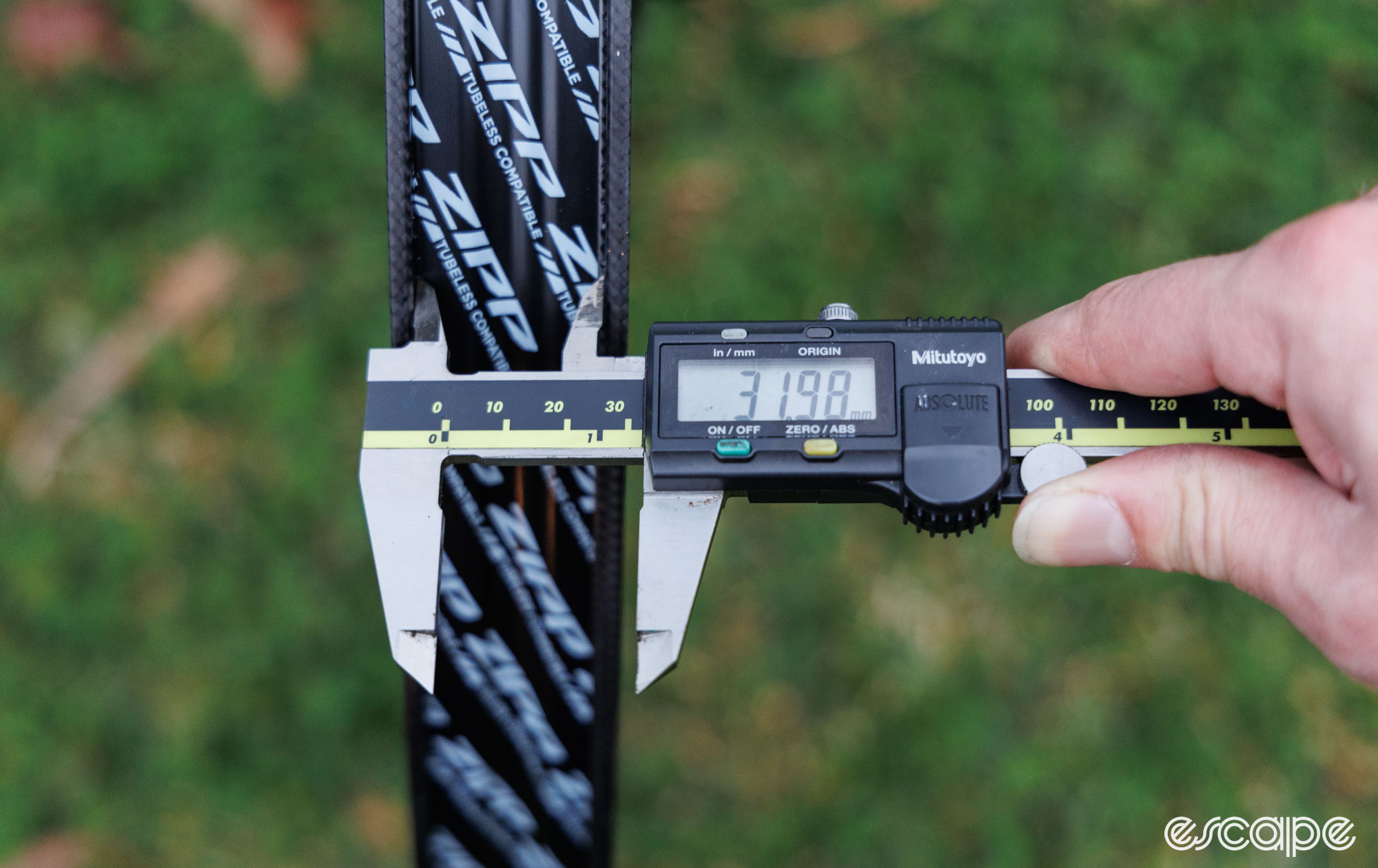

Before a tyre is added to this new compatibility list, Zipp tests it by stepping up pressures 10 psi at a time for hour-long periods until reaching 150% of the max system pressure. The combination must also pass the tyre manufacturer’s internal testing and be given the go-ahead by that respective company. If all tests are passed and the tyre company agrees, then it’ll make Zipp’s self-published approval list.
Currently, the list is short and reminiscent of the early days of road tubeless. Zipp claims its working with another five tyre brands, but at the time of publication, the following gravel tyres are all that are approved:
- Goodyear XPLR Slick Fitment series 40 mm
- Goodyear XPLR Inter Fitment series 45 mm
- Zipp G40 40 mm
- Schwalbe G-One range (all models, 40 mm or bigger)
While not officially stated by Zipp, it should also be safe to say that any tubeless mountain bike tyre over 58 mm (2.3in) in width will be OK to use, too. Still, that currently leaves a notable 46-57 mm gap in available options.
Those Goodyear XPLR Fitment Series tyres expand on the recently introduced Fitment Series tyres for the Firecrest rim range. Priced at US$80 / €90 / AU$140 each, these 40 mm semi-slick and 45 mm low-tread tyres feature a casing, tread pattern, and tread cap designed specifically for the wider 32 mm rim width. Meanwhile, rubber compounds, casing construction, and bead technology are shared with Goodyear’s equivalent tubeless offerings tyres.
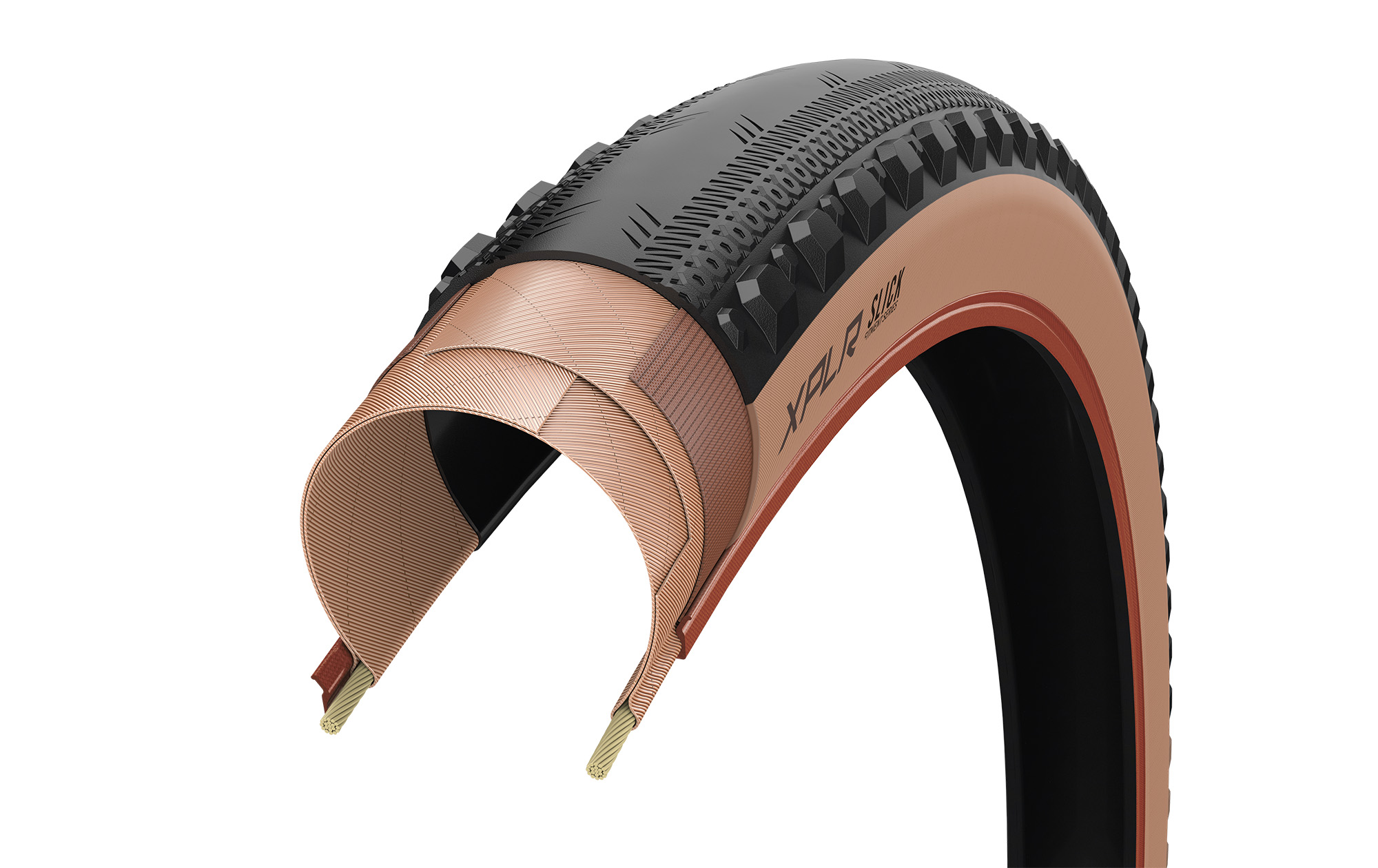

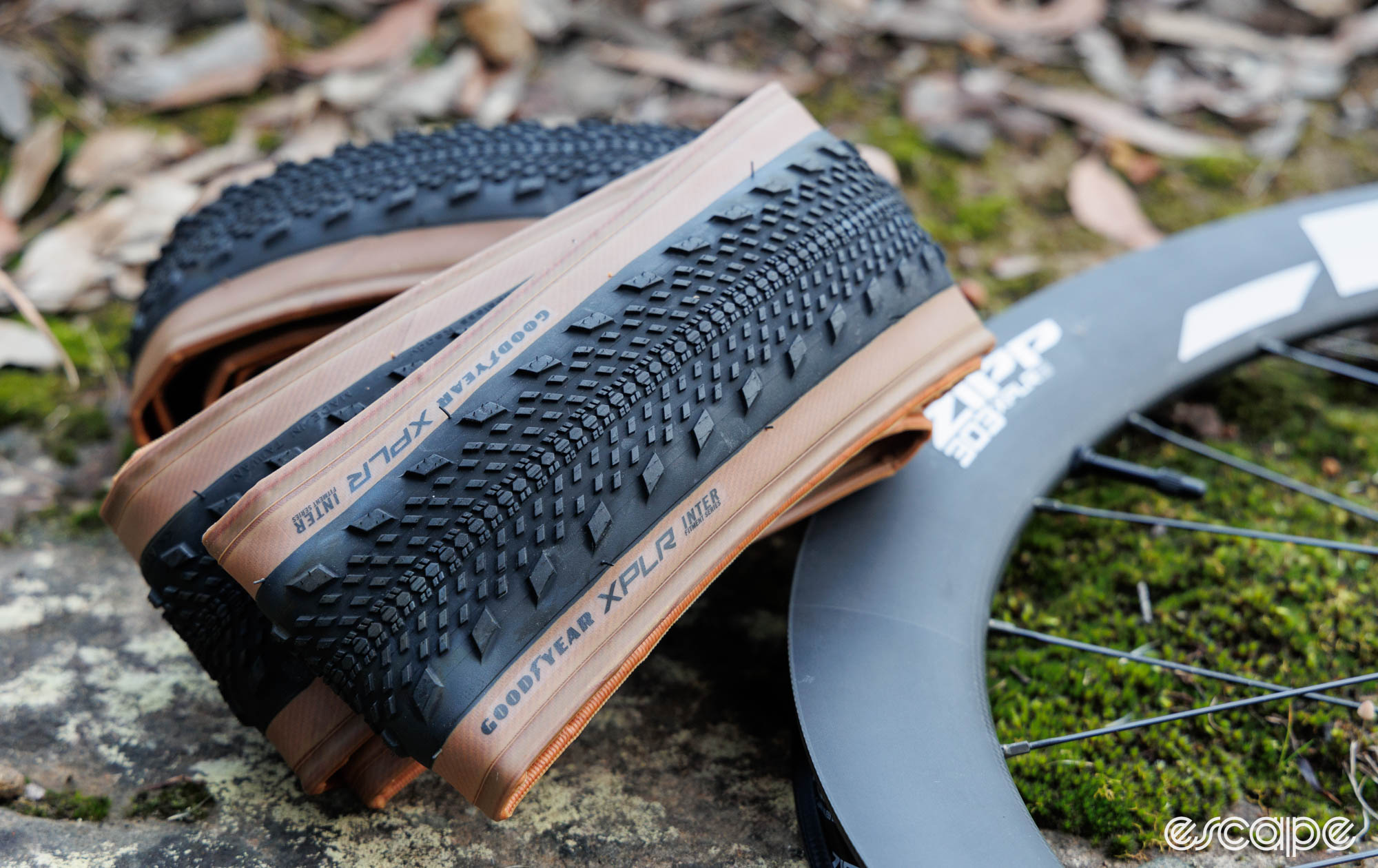

As tested, the Goodyear XPLR Fitment Series Inter (intermediate) 45 mm tyre offers a tread pattern close, but not identical to, Goodyear’s Connector gravel tyre. It’s a shallow-knob tyre with a closely packed centre tread, with my samples weighing 506 and 510 grams each. As the name suggests, the claimed 455 g Goodyear XPLR Fitment Series Slick 40 mm tyre offers a slick centre tread that moves to a progressively knobbier pattern toward the outer edge. Currently, the collaboration doesn’t extend to a super knobby or wide tyre for chunkier terrain.
As a reminder, all hookless road and gravel rims require a stretch-resistant tubeless tyre for safe and approved use. These new 303 XPLR rims are no different, and so they will forever be limited to tubeless-specific tyres. And while I’m not sure why you would, you can opt to run inner tubes within any compatible tubeless tyre.
Like other hookless wheels, there are strict maximum tyre pressure guidelines to adhere to, and it’s not the 72.5 psi you may already be familiar with. Here, Zipp sticks with ISO-provided figures, stating a 51 psi (3.5 bar) maximum for tyres with printed widths of 40-44 mm. Tyres in the 45-54 mm width range have a maximum recommended pressure of 44 psi (3 bar), and tyres labelled 55-64 mm can only be inflated up to 36 psi (2.5 bar). There is no minimum required pressure.
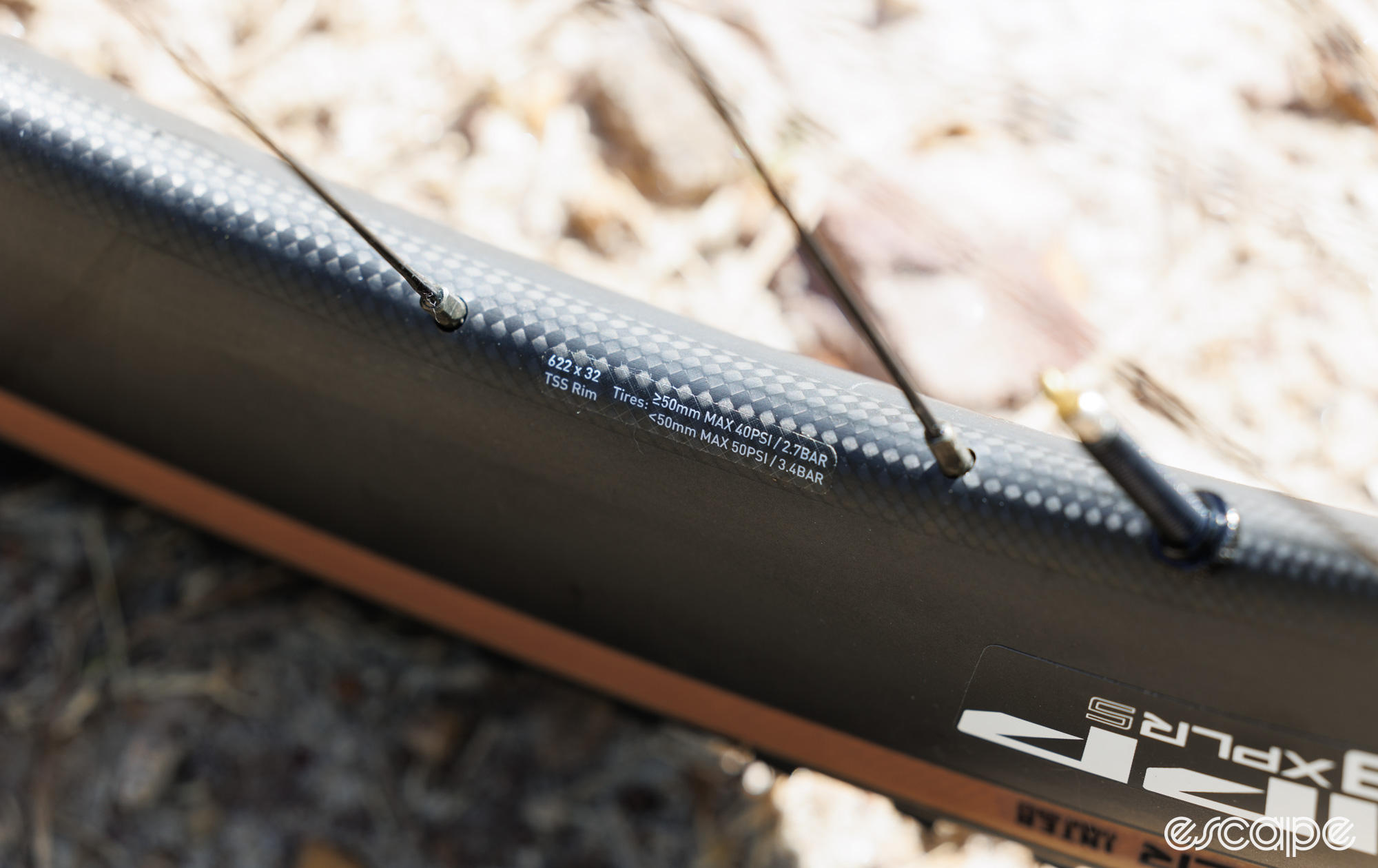

As it currently does for its pre-existing hookless wheels, Zipp will have recommended pressure charts along with its online calculator. Escape Collective was informed that the online calculator is receiving important updates that will warn users when they fall outside of safe pressure limits or incompatible tyre combinations—a glaring omission of the calculator in the past.
The pressure calculations are based on system weight, effectively rider plus bike, and will likely spit out a number that seems staggeringly low for those not from the mountain bike world. For example, my complete system weight of 80 kg has Zipp recommending approximately 24 psi (1.62 bar) and 25 psi (1.72 bar) front and rear, respectively, for the 45 mm Goodyear XPLR Inter Fitment series tyre.
Zipp’s preexisting 25 mm hookless rims often force heavier riders to use wider road tyres to stay within the pressure guidelines. Thankfully, the XPLR system seems better equipped to keep riders within the recommended maximum 130 kg (286 lb) system weight limit on their preferred tyre widths, assuming that width is 40 mm or larger.
All of this is OK so long as shops, mechanics, and consumers know of these safety-critical limitations and compatibility restrictions. Time and time again, experience has shown that not everyone can be trusted to have nice things, and it’s still fairly frequently that we hear of riders (and even some shops) unknowingly matching their hookless rims with non-tubeless tyres pumped up way beyond maximum allowed pressures. That’s the big issue here, and I’d have liked to see more from Zipp in the way of clear and blatant warning stickers to ensure anyone on these wheels stays within the provided narrow lane.
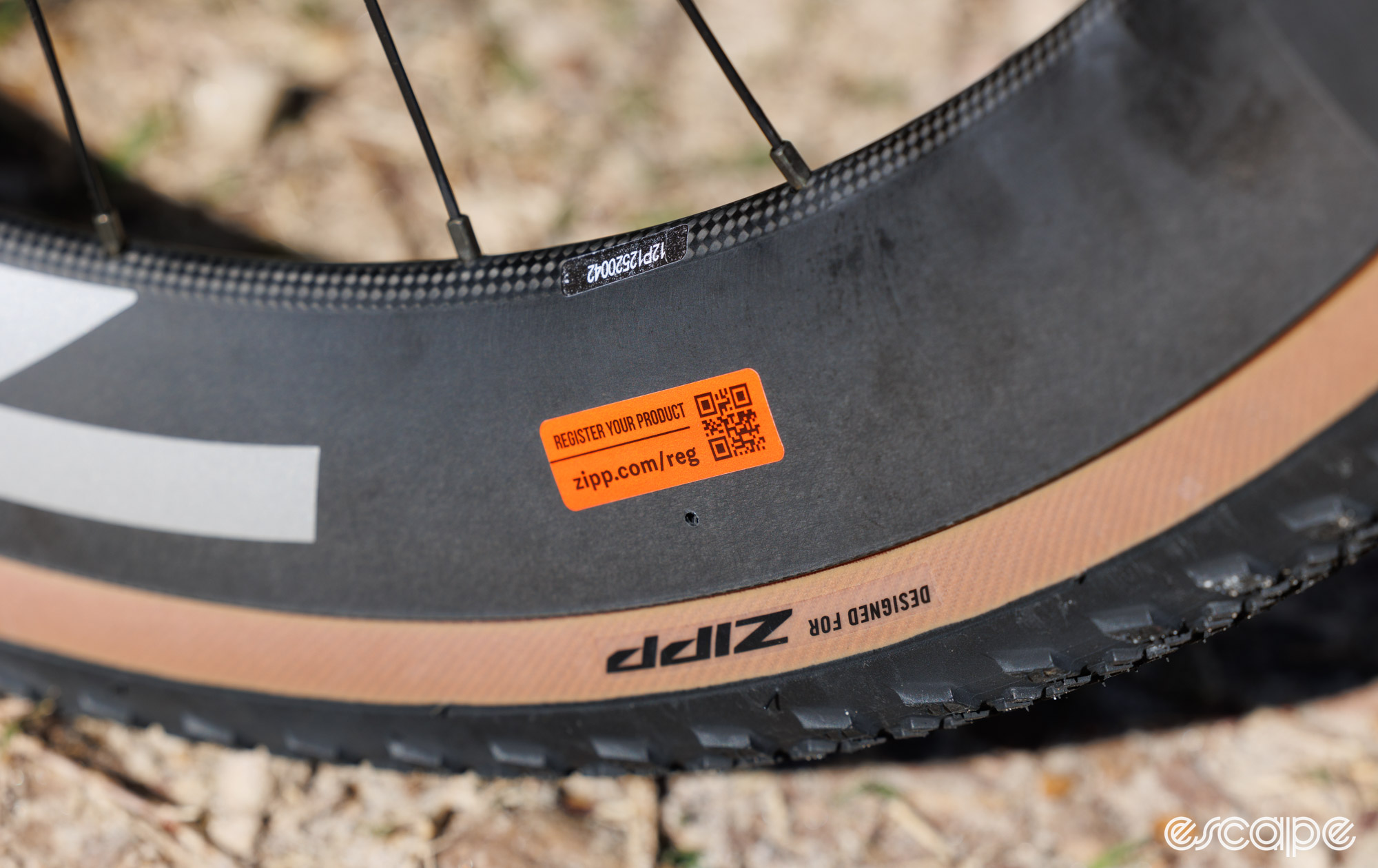

Installation and setup
I’ve been testing the new 303 XPLR S wheelset with Goodyear XPLR Intermediate Fitment series 45 mm tyres. It’s still early days in this testing, and to date, I’ve only tried the wheels with this one set of tyres, a result of the incredibly limited list of suitable options.
The wheels come pre-taped and with valves installed, ready to be set up tubeless. My general experience with Goodyear’s Tubeless Complete tyres has been largely positive, with snug but not annoyingly-tight fitment, easy beading (inflation), and impressive air retention (added sealant exists to seal punctures, rather than make the tyre hold air). The Goodyear Fitment Series tyres are no different in this regard.
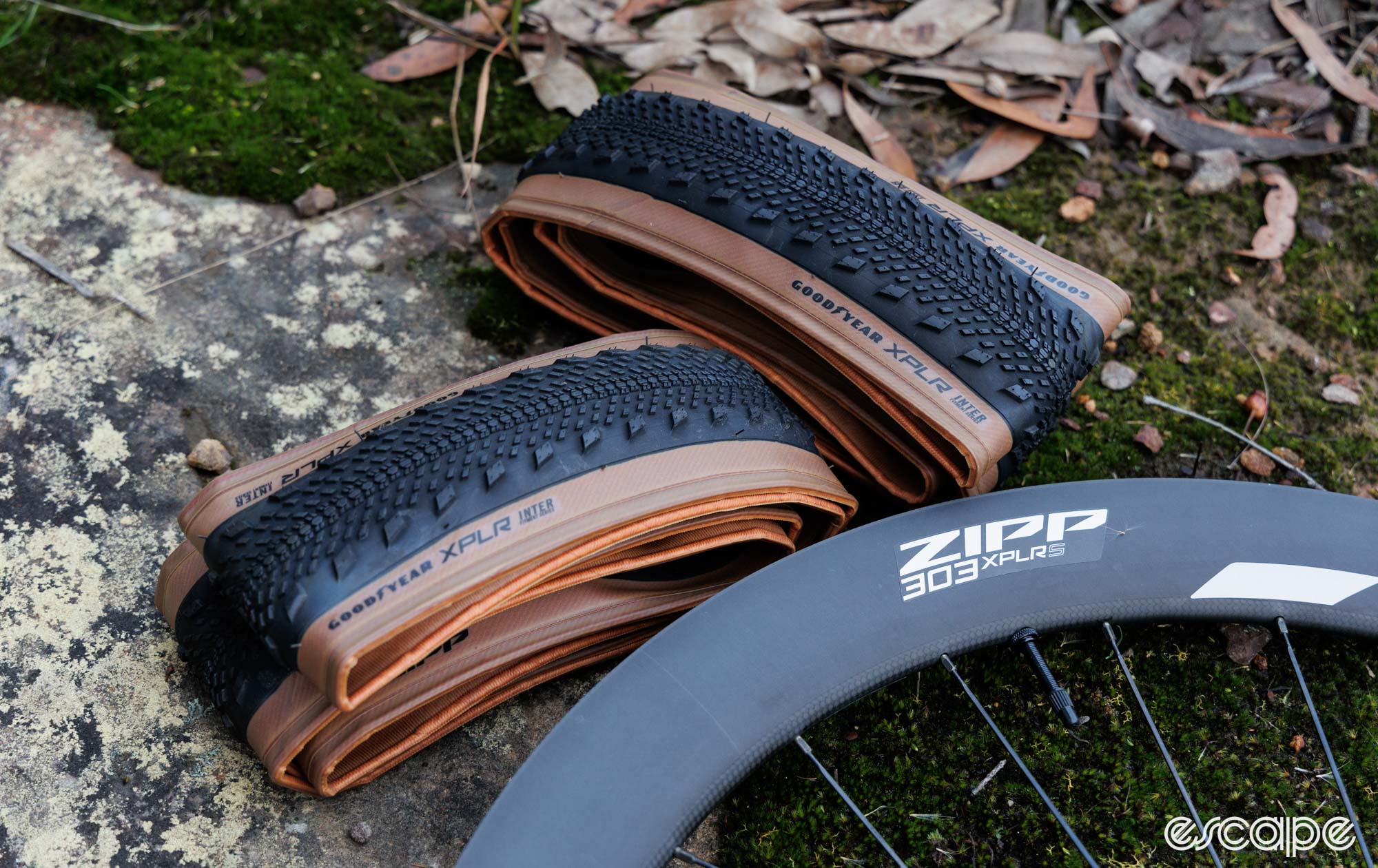

Installation of the tyre is made a tad tougher by a relatively shallow centre channel in the rim and the extreme rim width effectively giving more distance for the final bit of tyre bead to overcome. Still, the careful help of a single tyre lever was all that was required. From there the tyres inflated easily with both a Fumpa (small electric tyre pump) and a floor pump.
Once inflated, the fitment feels solid. Goodyear’s Fitment Series tyres are designed to measure exactly as quoted on these rims. The 40 mm version should measure an actual 40 mm, while the 45 should measure 45 mm. Rather unexpectedly, my 45 mm sample tyres only measured as wide as 43.7 mm (after a few weeks of use, too). It’s not a deal breaker, but it’s a different number from what Zipp claims.
In tyres that aren’t the Goodyear Fitment Series, you can expect the printed tyre size to balloon out to a wider measured width. I’d anticipate those compatible Schwalbe tyres to measure approximately 3 mm wider when on Zipp’s XPLR rims. Either way, strongly consider the maximum clearance you have available before buying into these wheels, as after all, the rims alone may be too wide for some frames.
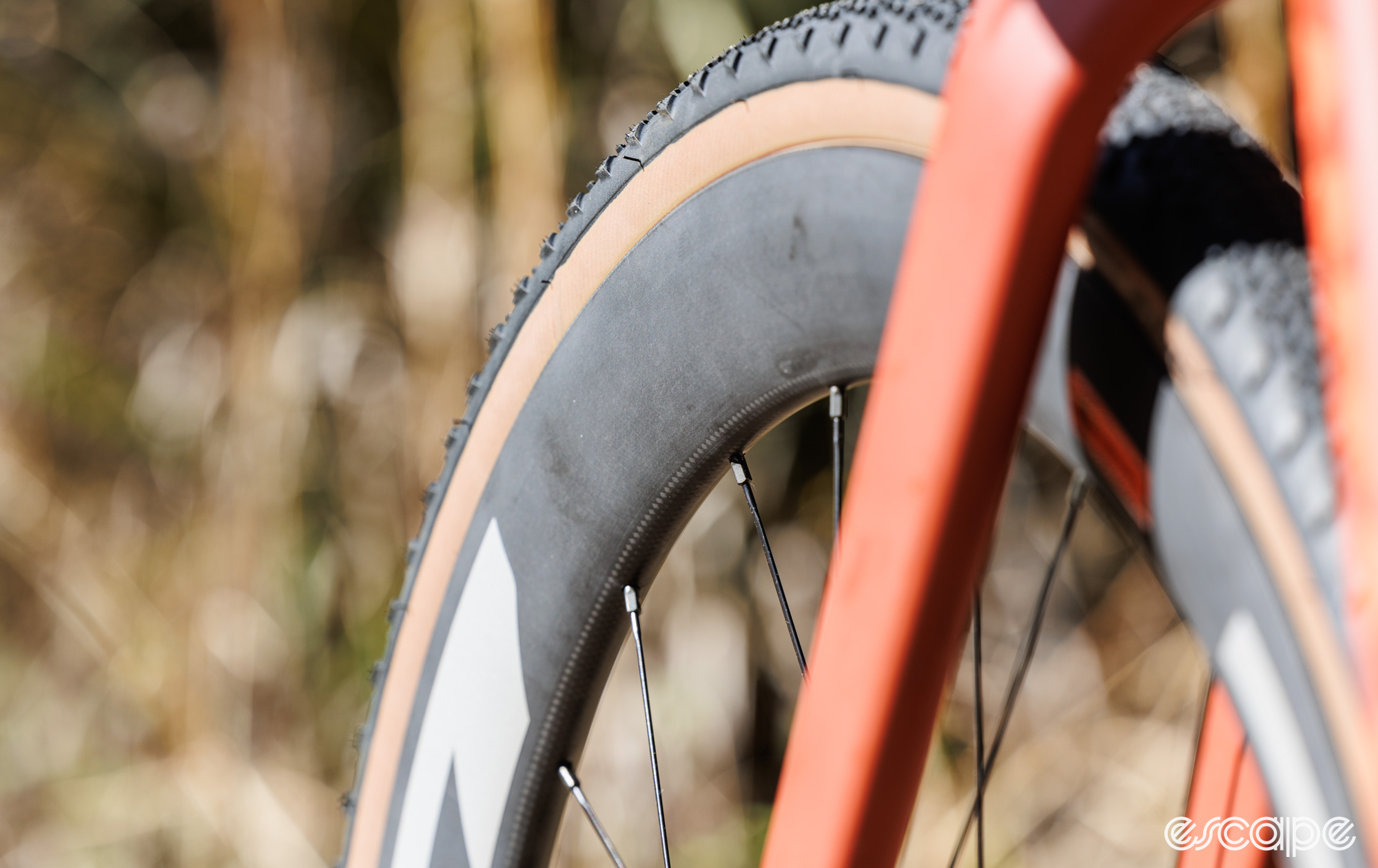

Some tyre and rim combinations in the market seem to lock together, making removal like a professional-level thumb war. That’s not the case here, and tyre removal a few weeks after mounting was of little stress to my dainty digits.
Away from the tyres, the rest of the wheels exhibited a good level of trueness with high and even spoke tensions that point to a rim with good finish quality and a build that should last. Similarly, the lack of spoke settling (often heard as a pinging sound) suggests Zipp is doing appropriate pre-stressing of the wheel.
The wheels are set for now-standard 100×12 mm and 142 x 12 mm axles, front and rear respectively. The rotor mounts are centerlock, with Zipp providing its own external-type lockrings.
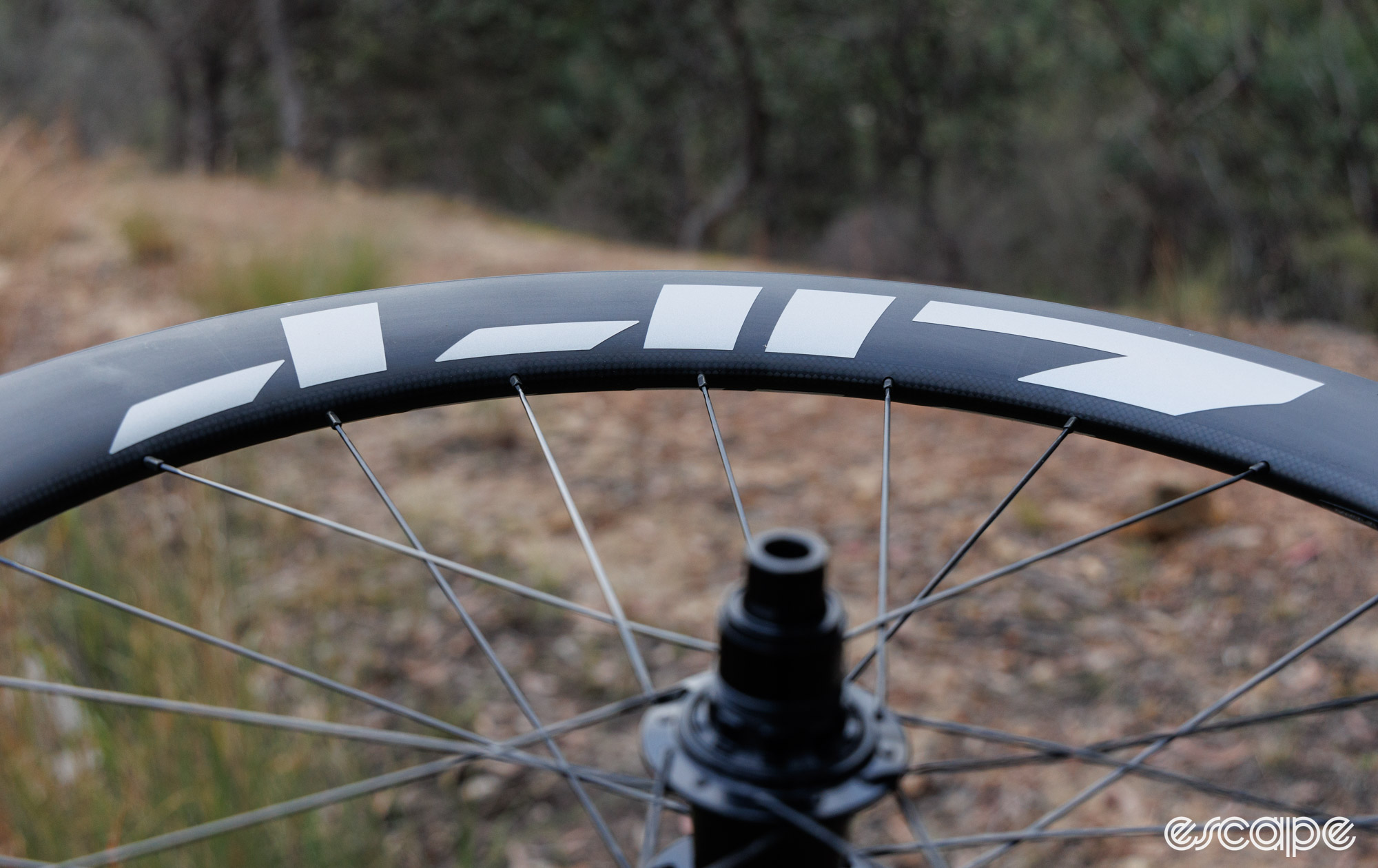

When it comes to the less-than-subtle logos on the rim, beauty is in the eye of the beholder. The good news is that these are just decals; you can remove them if you wish, and I suspect it won’t be too long before a third-party creates aftermarket alternatives.
Fast gravel, yes
If your idea of gravel involves riding at tarmac-like speeds along a wide variety of roads, whether sealed or unsealed, then an aero gravel wheel is likely the right fit. If you can safely and comfortably drive the family sedan on the surface, then the 303 XPLR wheels can be a rapid choice.
As intended, the inflated Goodyear Inter tyre creates a uniform shape with the rim that, just looking at it, looks like it would retain air more smoothly than a big ballooning tyre on a narrower rim. Indeed a 40 mm measured tyre would be best in this regard, but the tyre sidewall of the quoted 45 mm tyre hardly protrudes the wide rim. While I haven’t created a single spreadsheet of related test data, my perception of power for a given speed does suggest these roll along with a good amount of efficiency.
What I can say without doubt is that these wheels are surprisingly great in gusty conditions. Keep in mind that the deep 54 (ish) mm rim and 45 mm quoted tyre create a package depth of around 91 mm, and I fully expected these to be blown about more than a flag. Rather, on a day when trees were being blown over and I could feel my bike in a different plane to my body to ride straight, I experienced a wheel that felt largely stable. There was no scary tugging at the bars from the wheel or the feeling the bottom of the bike was trying to push out from beneath me. Most importantly, the wheels handled the wind in a way that didn’t distract from the ride. Well done, Zipp.
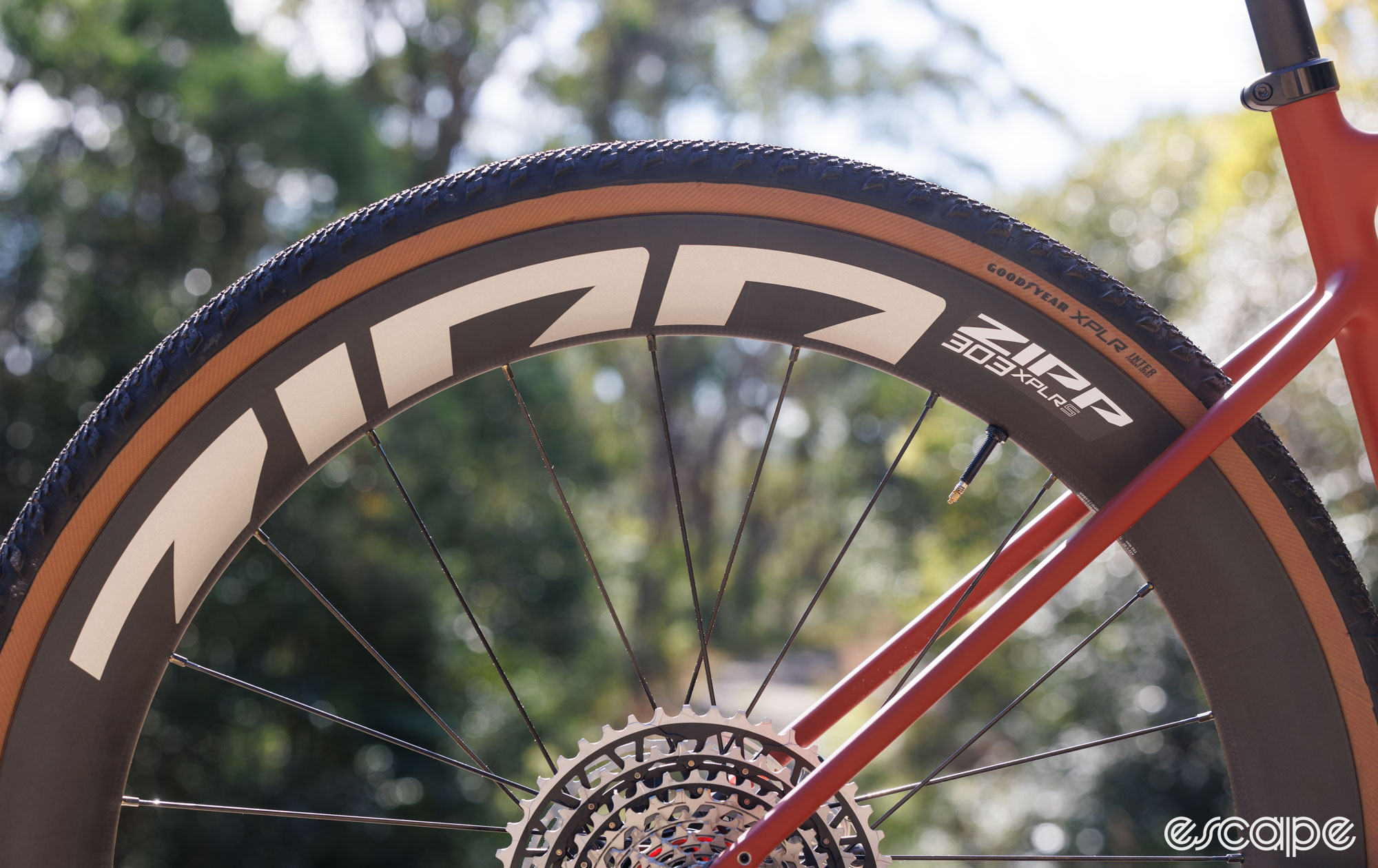

A huge part of the speed claims associated with these wheels revolves around the concept of making the rim wider in order to reduce tyre pressure and therefore vibrational losses. If you can imagine riding on a marginally bumpy unsealed road with a glass of water on your bars, the dream is to suspend the bike (and rider) enough to avoid spilling.
When ridden on buzzy but not rough terrain and at the right pressures (I settled on 23 psi front, 24 psi rear), these wheels do hum along with impressively little effort. Once at speed, the ride is smooth and efficient, and it simply feels like you’re not adding power merely to retain momentum, but rather to actually go faster.
These pressures in a similar-width tyre but on a narrower rim would typically exhibit a decent amount of tyre sidewall flop and squirm, yet here that sidewall is kept noticeably more stable. Looking down, I can see the tread cap is actively working to follow the contours of the surface, but the sidewall is doing noticeably less. This seems to work wonderfully on fast gravel or when flying in a straight line.
The wheels’ thin construction through the centre of the rim seemingly helps to give them a ride quality that’s smoother than the depth and honking width would suggest. There’s still enough stiffness in the system to keep spoke tensions high and that rim bed within spec as tyre pressure is added, but it’s certainly no bone-shaker of a wheel.
Nothing happens in isolation
In all forms of cycle racing, the perfect setup will always be compromised. Often, it’s a matter of picking the setup with the fewest compromises or the one that will excel at the pivotal moment. Zipp’s new wheels offer some truly intriguing and sometimes tangible benefits, but I also can’t remember the last time I was this confused over my ride impressions.


The basis to such confusion relates to taking a rim wider than most mountain bike rims and running it with a significantly narrower tyre. I own three modern mountain bikes. They all feature rims with internal widths of 29/30mm and run between 59-66 mm wide tyres. For a 30 mm rim width (which is 2 mm narrower than the new Zipp XPLR), I’m often using a tyre in the realm of 61 mm (2.4in), partly due to volume, but also so to avoid a squared-off tread profile.
While SRAM’s liberties related to ISO tyre width recommendations and the resulting potential safety issues due to market confusion are significant, they’re not the only issue I have with the wheels. Rather, the rim is so wide that it introduces a bunch of truly nuanced compromises.
That extreme inner width combined with the low intended tyre pressures will square off the tread profile of most gravel tyres fitted to it, and in turn, you begin to run the tyre in ways the tread wasn’t designed for. With a squared-off profile, you introduce something I’ve heard famed Australian frame builder Darren Baum refer to as Rubber Trail, where effectively the increased contact patch has a similar effect to an increased trail figure on the bike. In mountain bikes, designers overcame this with wider handlebars and geometry changes, and while that’s all possible to do in gravel, it’s critical to note you can never just change one thing in isolation.
With the Goodyear Fitment Series tyres, that square profile is somewhat avoided; however, it becomes evident when tyre pressure gets to ideal comfort levels of low, and the bike then feels like it wants to understeer (especially on the road, where I’d liken the feeling to a worn-out headset). Unfortunately, I haven’t been able to test other tyres for the squaring-off of profile, but I’d certainly expect it. If Zipp’s move to way-wider-is-better wins out and other big wheel brands follow, then I’d say expect to see more tyre brands offer specific “wide tread” forms of tyres to suit.
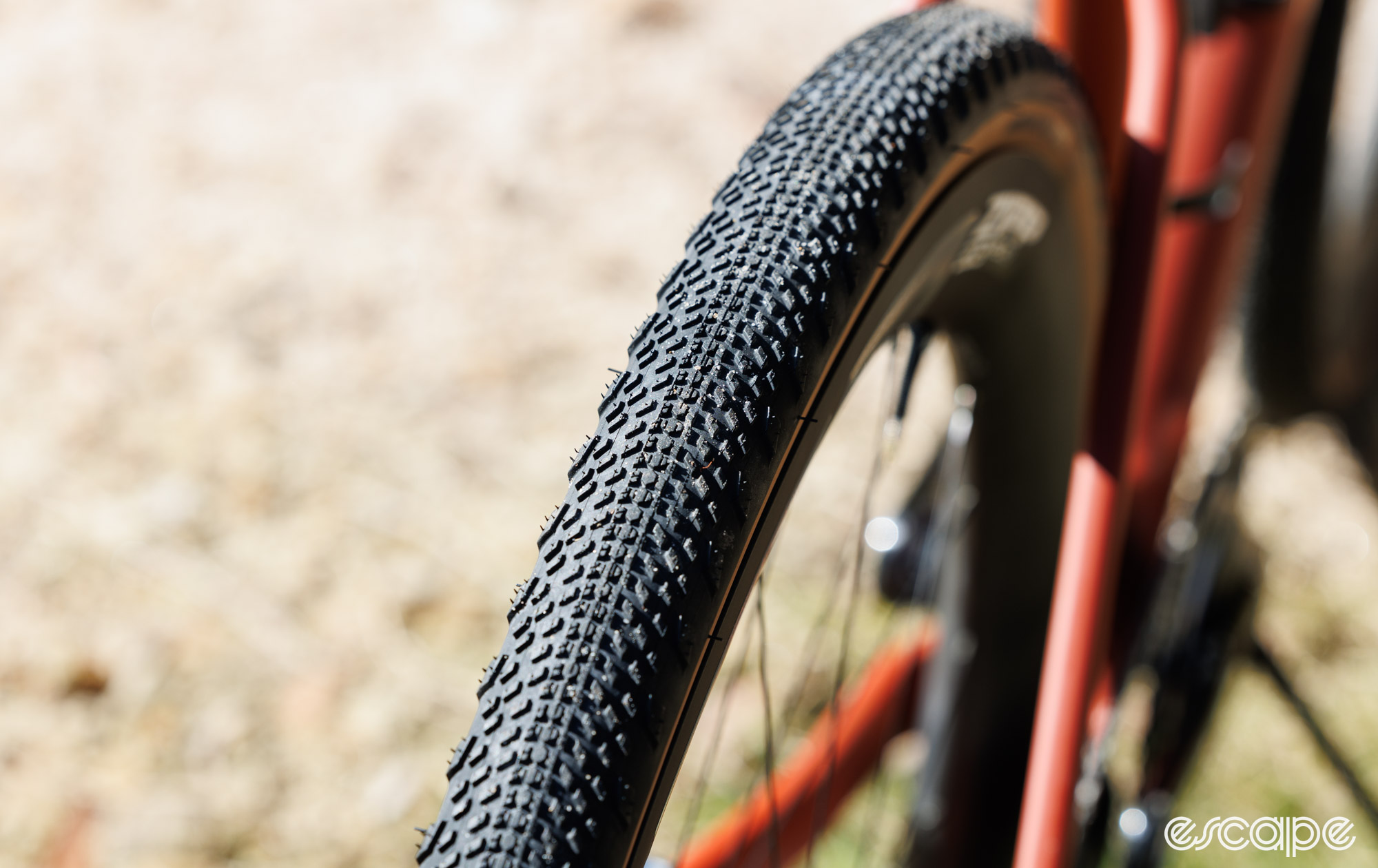

With the rim width giving more volume to an otherwise restrained shape, the tyre also exhibits a weird phenomenon where it’s noticeably more sensitive to the pressure you run (something previously experienced with the short-lived fad of Plus-sized mountain bike tyres in the 2.8-3in range). That understeer sensation was experienced by dropping a single PSI from the front wheel (23 to 22 psi). I had made that adjustment in the hope I’d get a more compliant and comfortable ride over rough terrain, but rather quickly felt the on-road steering go bad from too much rubber trail.
I found Zipp’s recommended pressures to be just about right, where a couple of psi less would result in the above-unwanted traits (and rim strike risk), and one psi more pressure would merely make for a noticeably rougher ride. Still, I could never escape the feeling that these 43.7 mm measured tyres still ride like they’re narrower than they really are. Square-edge hits just feel harsher when compared to a more traditionally ballooned-shaped tyre of an equivalent width.
My theory (and one partly informed by a source I can’t divulge) is that the extra support of the wide rim width actually works as claimed, but not wholly in a positive manner. The sense is that extra width is creating more tension in the sidewall of the tyre and making it a less effective spring. That’s great when running the low recommended pressures on the road where the tyre sidewall doesn’t seem to fold and squirm under your weight, but it’s less great off-road on an otherwise fully-rigid bike where your main suspension system is the tyres. Perhaps tyres with more pliable sidewalls will help in this regard, but the compatible options there are currently limited to Schwalbe.
No doubt these wheels roll great and offer a smooth ride on more buzzy-type conditions, but they begin to feel overwhelmed and rougher as the terrain gets more aggressive. Ride on a track with constant square edge hits, and suddenly it feels like there’s too much pressure in the system, but dropping it further introduces regular rim strikes and that unwanted understeer. It seems there’s a narrow margin of what the combined tyre width and Zipp’s intended pressures can handle well before the wheel is telling you it’s time to upsize to a bigger tyre (which then returns to compatibility limitations, increased weight, and aero sacrifices).
With the exterior of the rim sitting at 40 mm and closely inline to the tyre sidewall, I also experienced a vast increase in audible rim strikes when ridden in rough terrain or where sticks lay about. Most of these were experienced while riding through areas of exposed rocks where tyre sidewall cuts are likely, and the rims now show a few scratches to prove it. Worryingly the rims have a noticeably thin wall in the centre, where pressing too firmly with a thumb could cause damage, and therefore a rock at speed will be no friend.
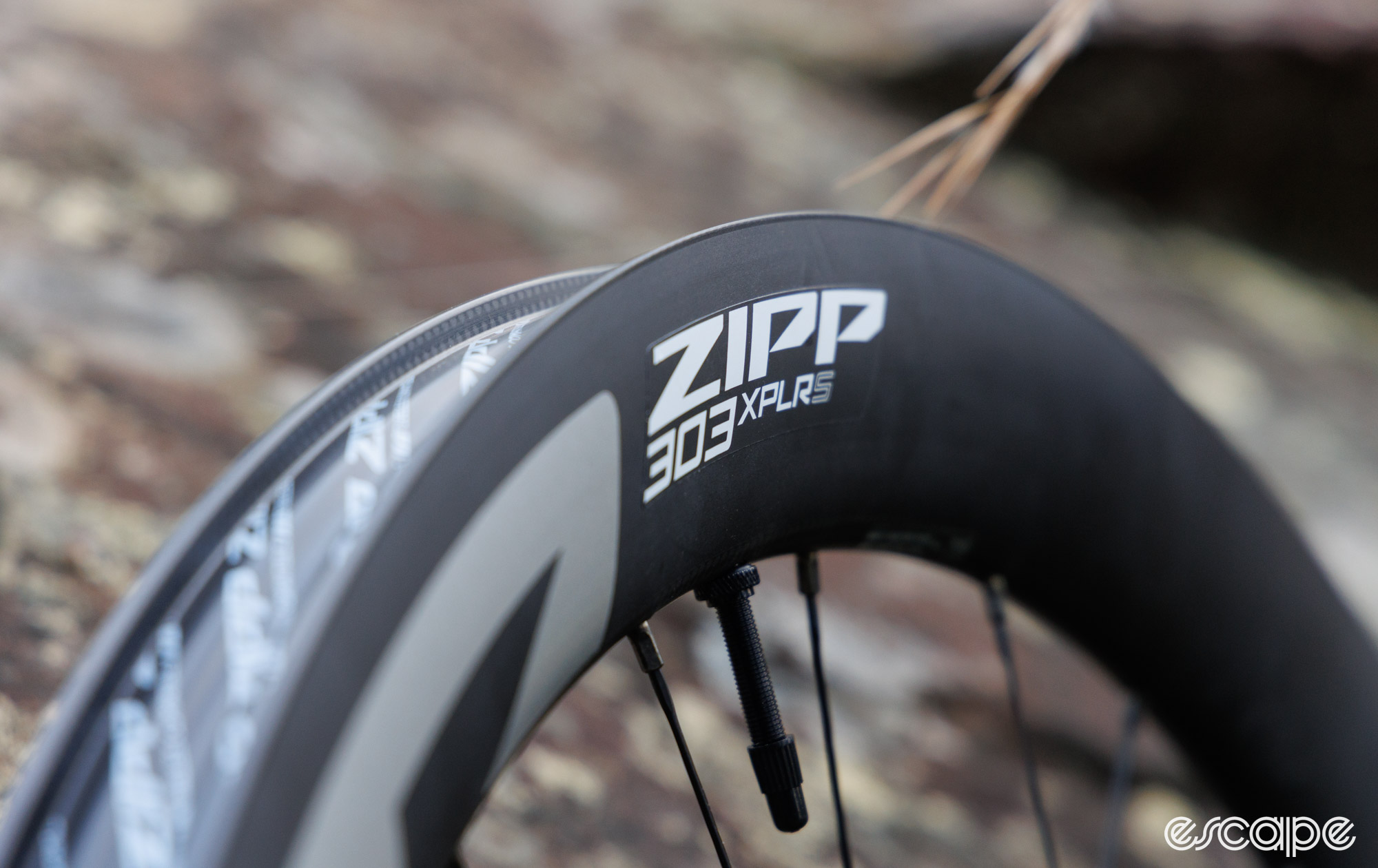

Some mountain bike rim manufacturers also previously learned the risk in going too wide, where the wider you go, the more likely a single rim sidewall will take the full impact of a tyre bottom out (compared to both sidewalls sharing the impact). To be clear, my sample wheels have shrugged off a handful of direct rim strikes to date without signs of issue or a pinched tubeless tyre, but it’s still worthy of mention.
I’ll avoid this becoming a tyre review, but it’s worth noting that while the wheels are intended for racing, Goodyear’s suitable tyres typically don’t appear at the pointy end of rolling resistance data tests. These tests aren’t the whole picture, and the tyres do many tyre-related things well, but it’s something the true watt-weenies should be considering.
Seemingly there’s a whole lot more to discover and test with these wheels, and a lot of that will come as more tyres become available. I’ve also blown the word count before being able to talk about the relatively light sealing in Zipp’s hubs or offer more ride insight into those Goodyear-made Inter tyres.
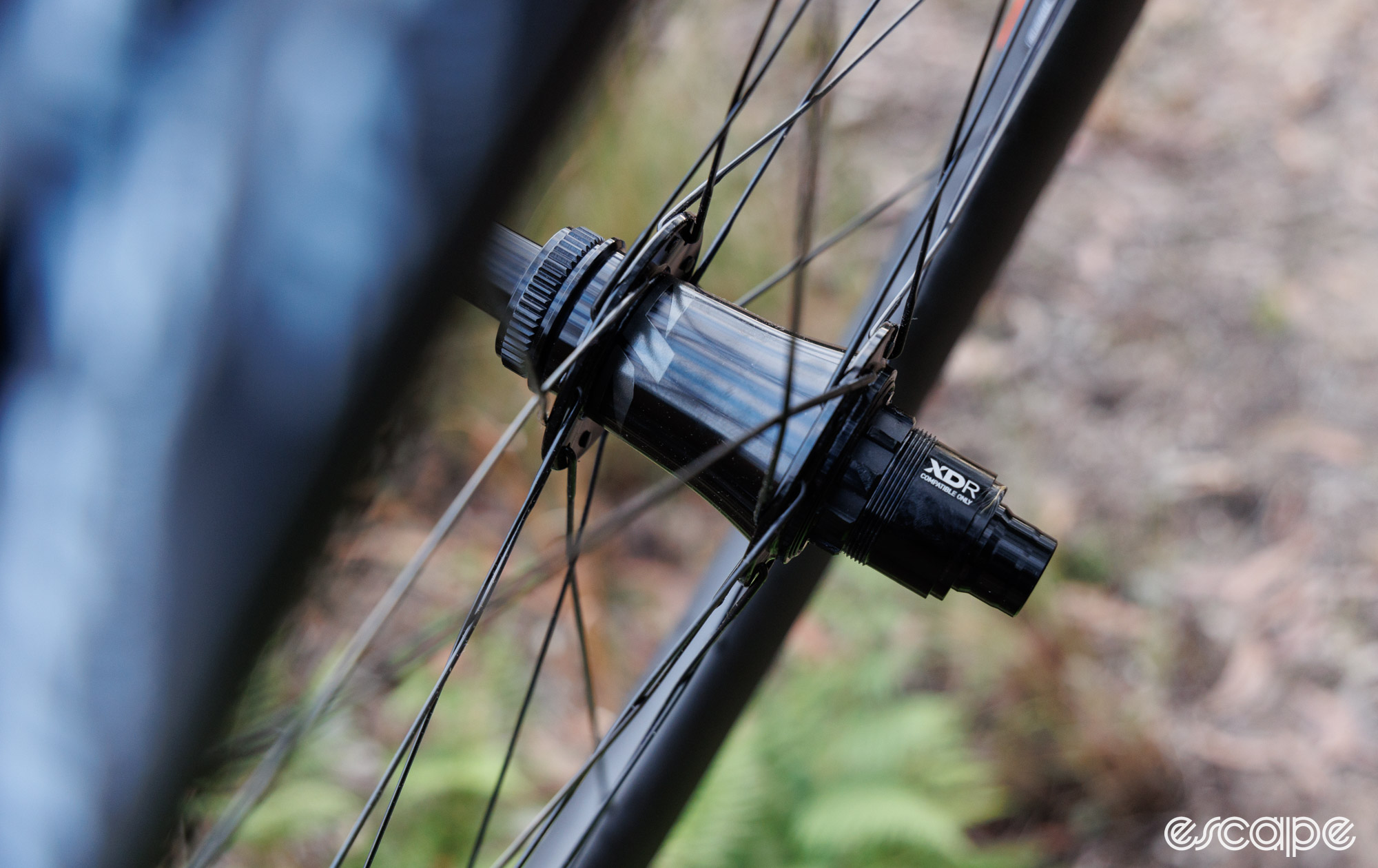

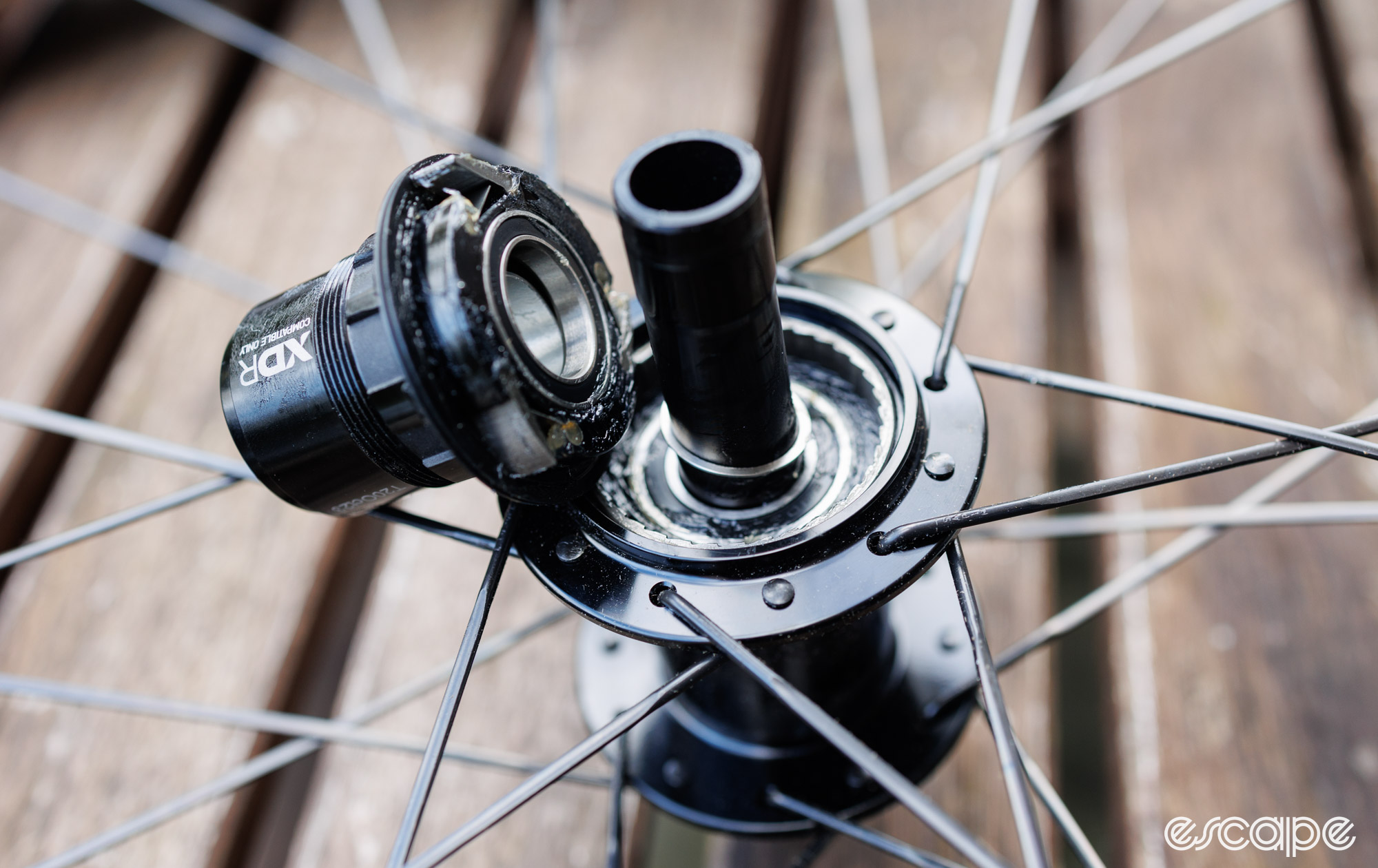

Zipp has done extensive research into efficiency over mixed surfaces, vibrational control, and the like. The company also told Escape Collective that its testing included rims as wide as 35 mm before reigning it back to 32 mm. I state this as what I’ve shared is largely based on feelings and with little empirical data. I’m not saying I’m wrong with my impressions, but I’m also wholly open to the fact that there are conditions where such a wide rim width excels, like champagne-type gravel or similar conditions. I just seemingly found the outer limit of its ideal application.
A wrap on the 303 XPLR
A more regular-width rim (say 25-27 mm) matched to a tyre large enough to run pressures similar to those in the Zipp 303 XPLR will give you a similar level of muted control and speed over faster terrain, and seemingly, more comfort when things get rough. However, Zipp’s goal in the 303 XPLR is to introduce the benefits of lower tyre pressure while still keeping things aero. The American brand has seemingly achieved what it set out to, but it’s not without compromise and limitations.
If you’re riding the type of terrain where 40-45 mm tyres excel, where speeds are high, and aero is of a legitimate concern, then an aero gravel wheel should be a consideration. Zipp’s approach is an extreme one, and while there’s merit to it, I believe its success currently falls in the lap of more tyre brands approving it. Zipp claims more compatible brands are on the way, but I do have concerns that people may start to experiment with non-approved combinations to fill the gap. Things could get messy from here.
I’m left thinking about the new Zipp XPLR wheels as one of those rare products that I could dedicate a year of my life to testing and still not have all the answers (don’t worry team, I won’t). There’s a lot to consider here, but for my steep and rough local terrain where average speeds are lower, you’ll soon find me back on a shallower and less wide wheel running a lightbulb-shaped tyre.
A short side-bar on the Zipp handlebar
Zipp SL 70 XPLR carbon gravel handlebar
Good stuff: Lovely integration features with SRAM AXS, a good example of where handlebar concepts are headed (Shimano’s Pro Bike Gear is on a similar path), nice shape and angles, 70 mm reach, can be used with aero bars (if that’s your style).
Bad stuff: Not as compliant feeling as it could be, price.
Just as Zipp introduced a matching road race handlebar with the release of SRAM Red AXS, the brand has created a handlebar pairing for the new Red XPLR AXS. The bar is the Zipp SL 70 XPLR, a US$320 / €360 / AU$550 carbon handlebar with a bunch of nice features.
It’s available in widths from 40-48 cm (measured at the hoods), with a 5° flare for the hoods, and 11° flare for the drops. There’s a 115 mm drop, a welcomed 70 mm reach, and 3° backsweep on the tops. The drop shape is designed to match the shaping of the new Red AXS lever.
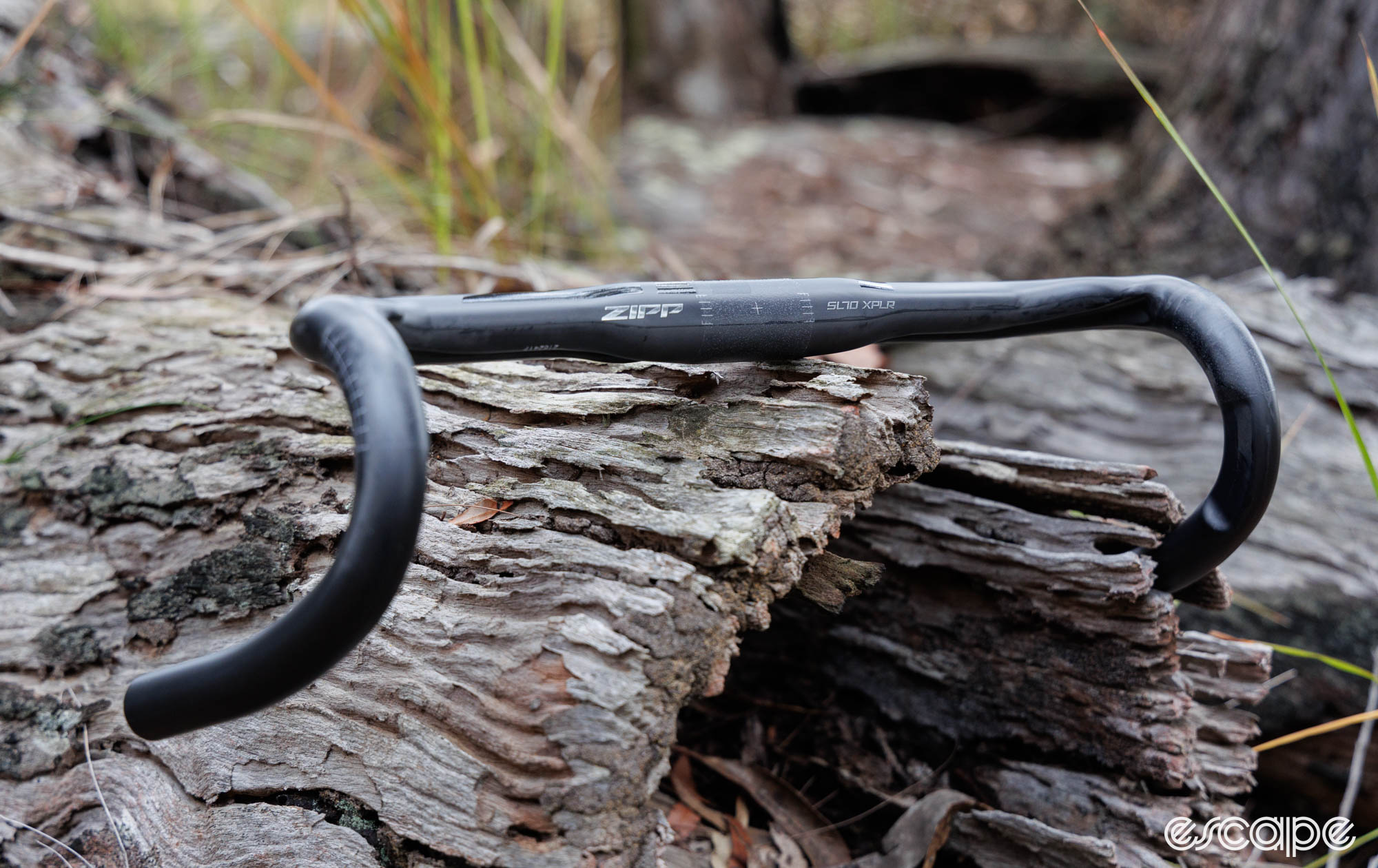

Like the new SL 80 Race road handlebar, this bar features indents for mounting optional wireless Blip buttons, and little plastic covers are given to fill in the nook on the drops if you’d prefer.
The bar features an ergonomic overhang that fills the usual gap behind the shifter. Designed to fit common 31.8 mm-diameter clamp stems, it has a generous 100 mm-wide clamping area on top for accessories and is approved for use with aero bars. I also really like the external brake hose channelling that allows for either traditional or through-stem routing (something I first saw Cervelo do). My 40 cm test sample weighed 228 grams.
Zipp claims the bar to be compliant, and while it’s not entirely rigid, it’s still noticeably stiffer than equivalent bars such as the Roval Terra and Easton EC90 AX.
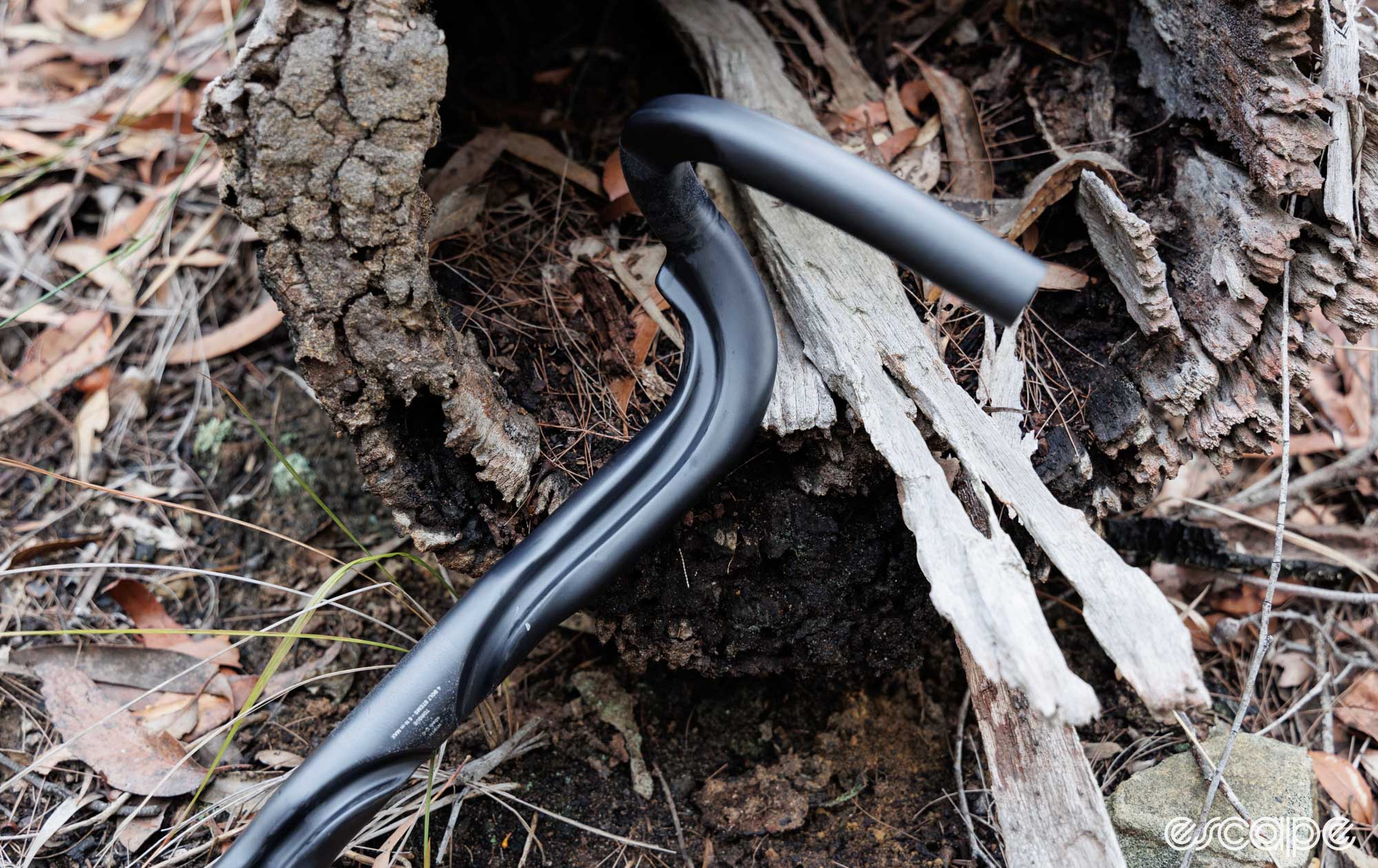

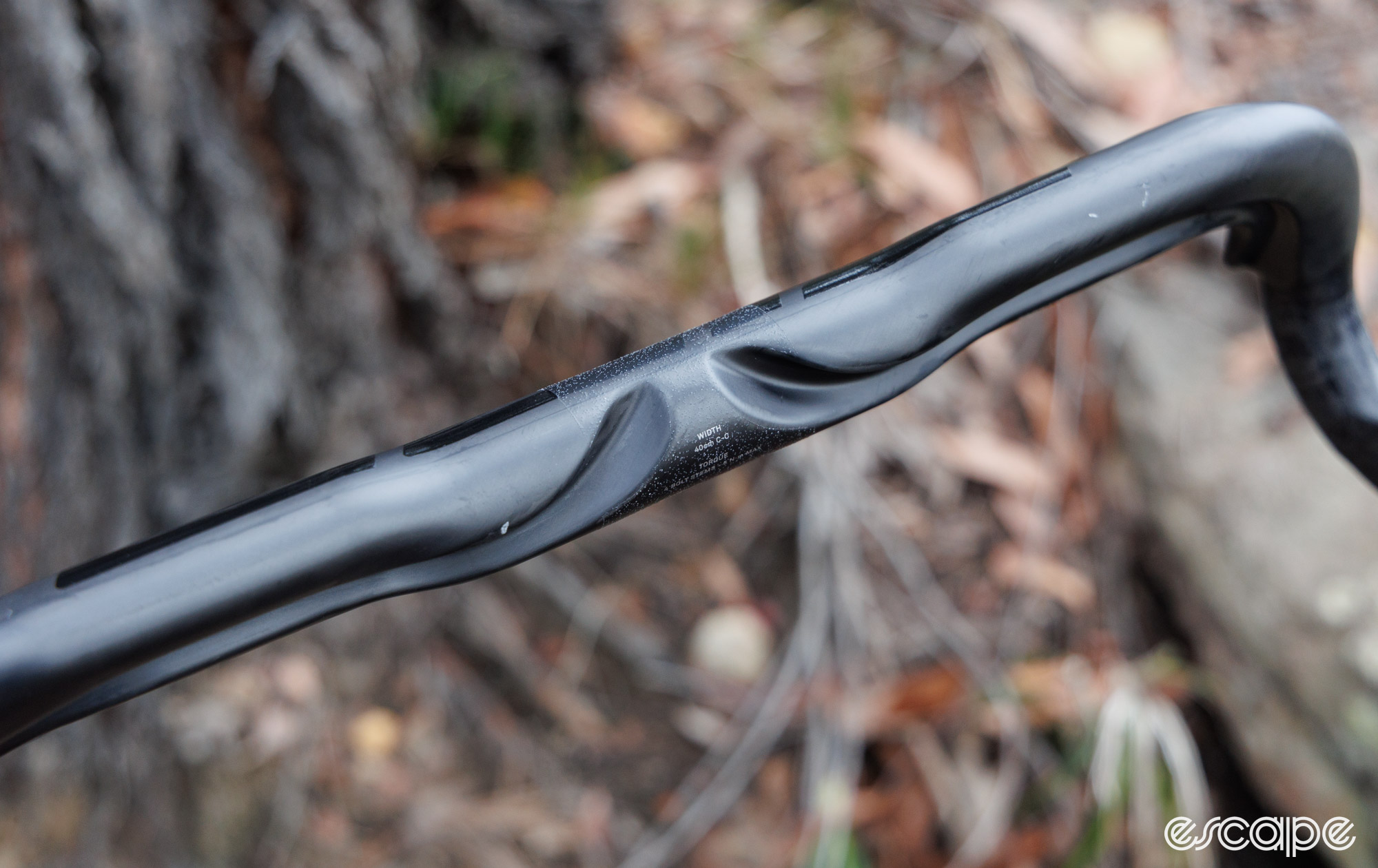

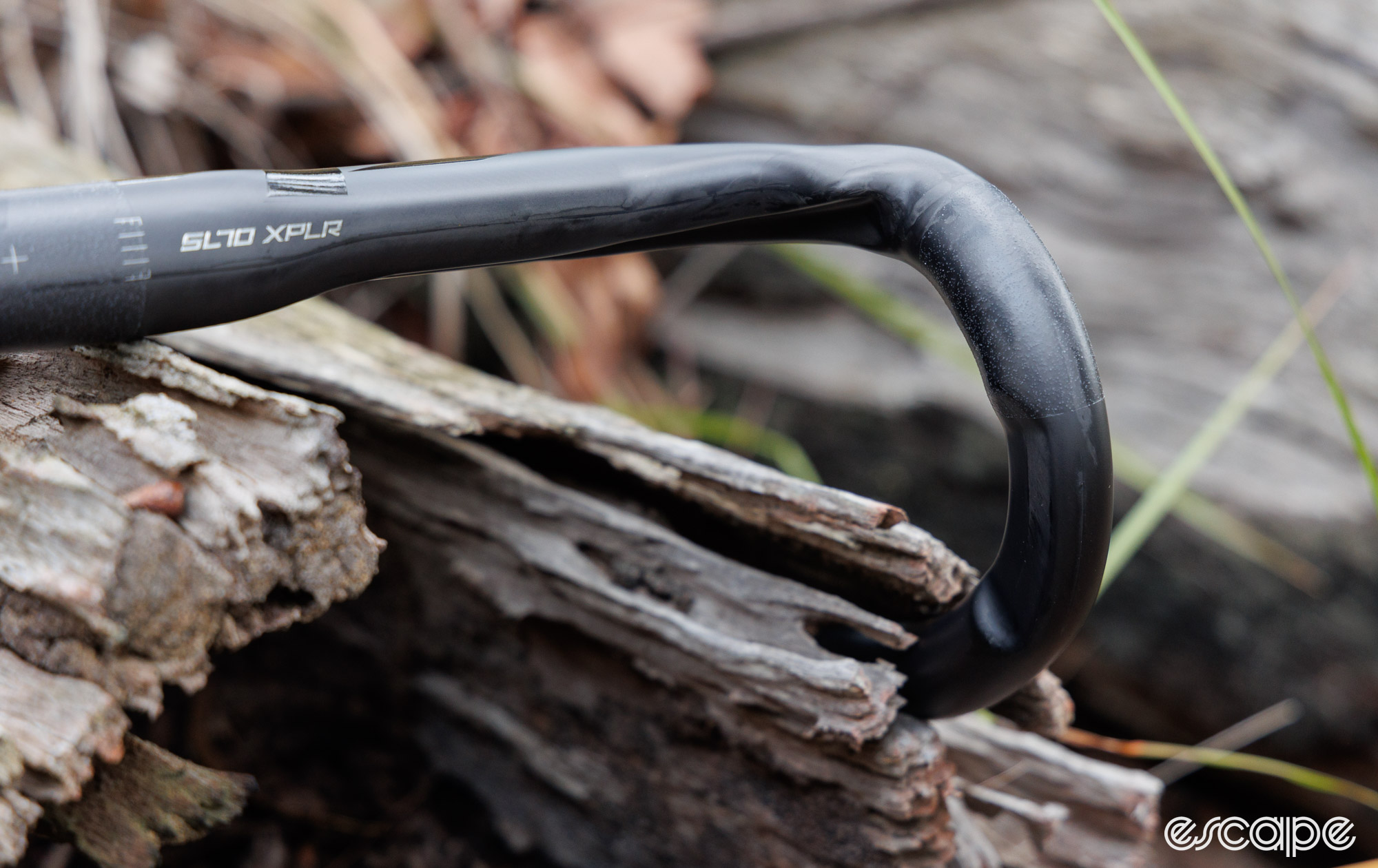

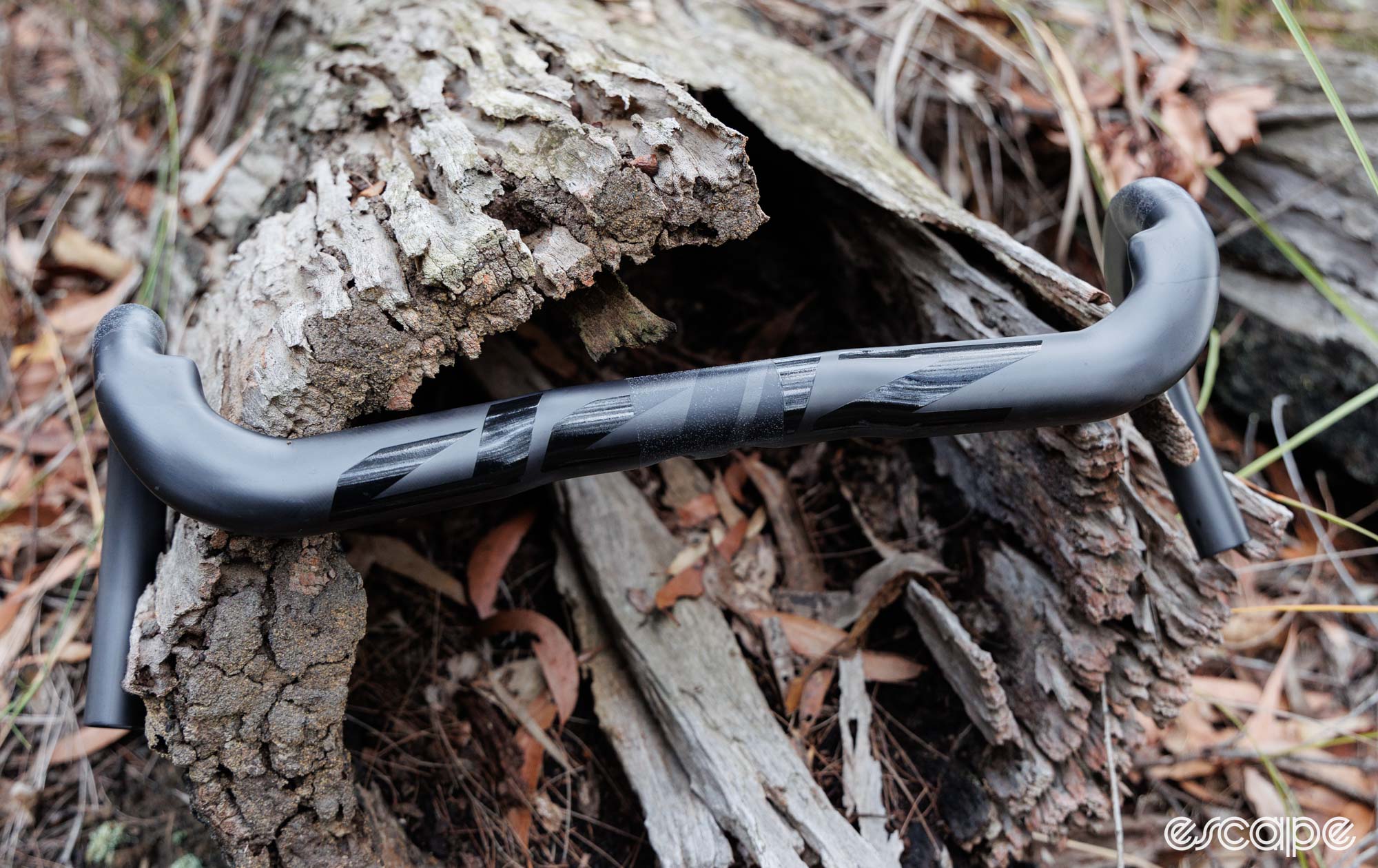

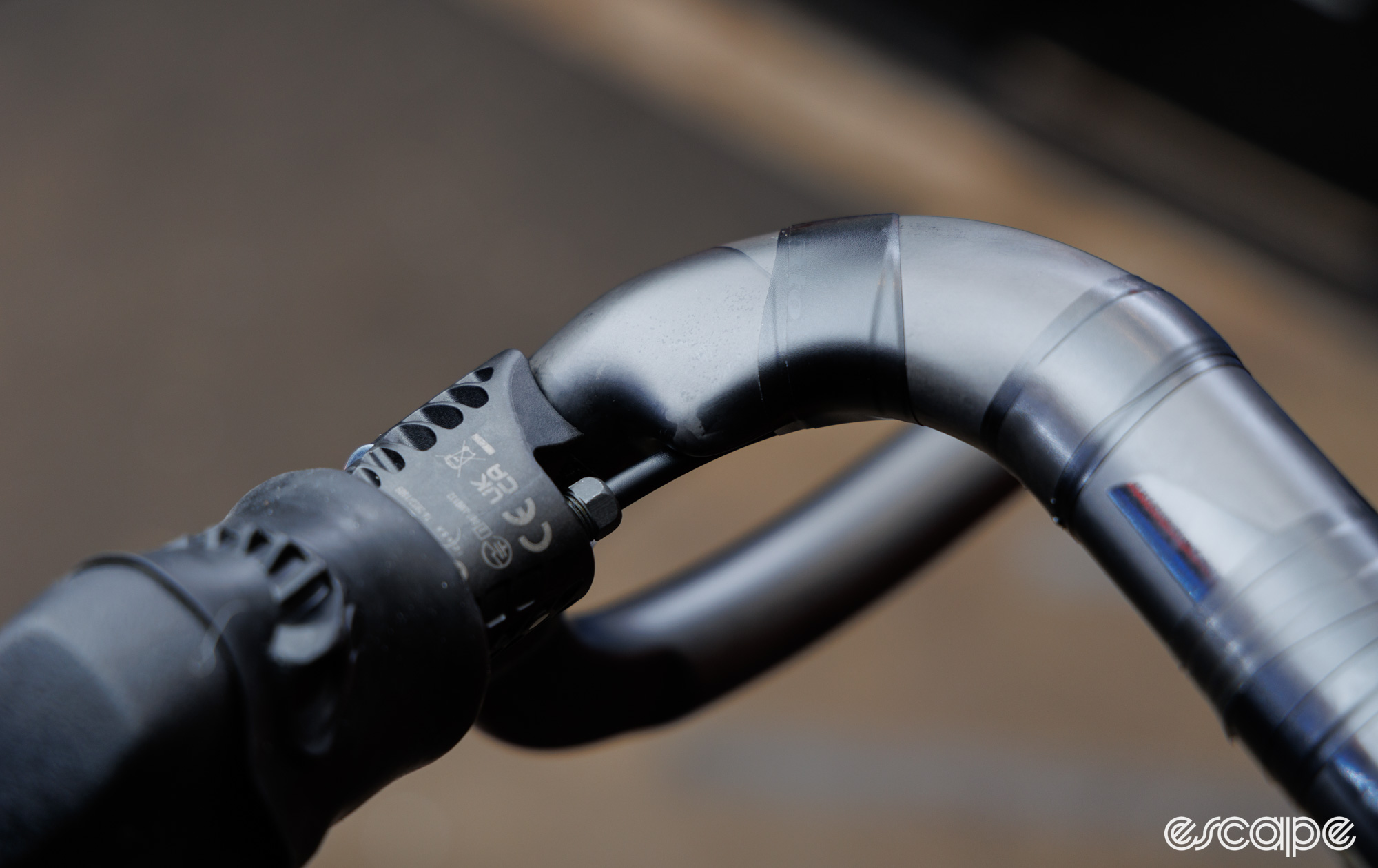

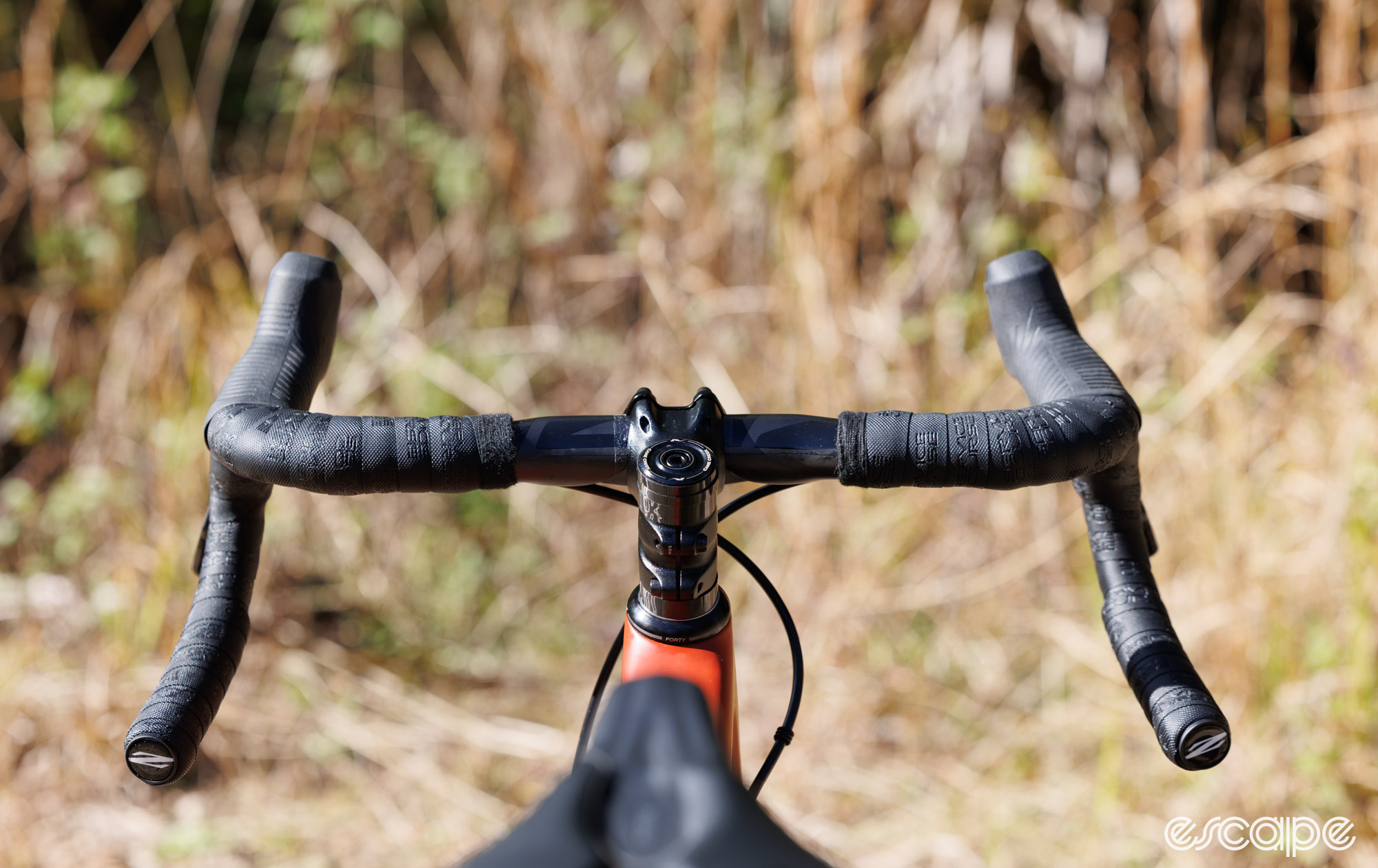

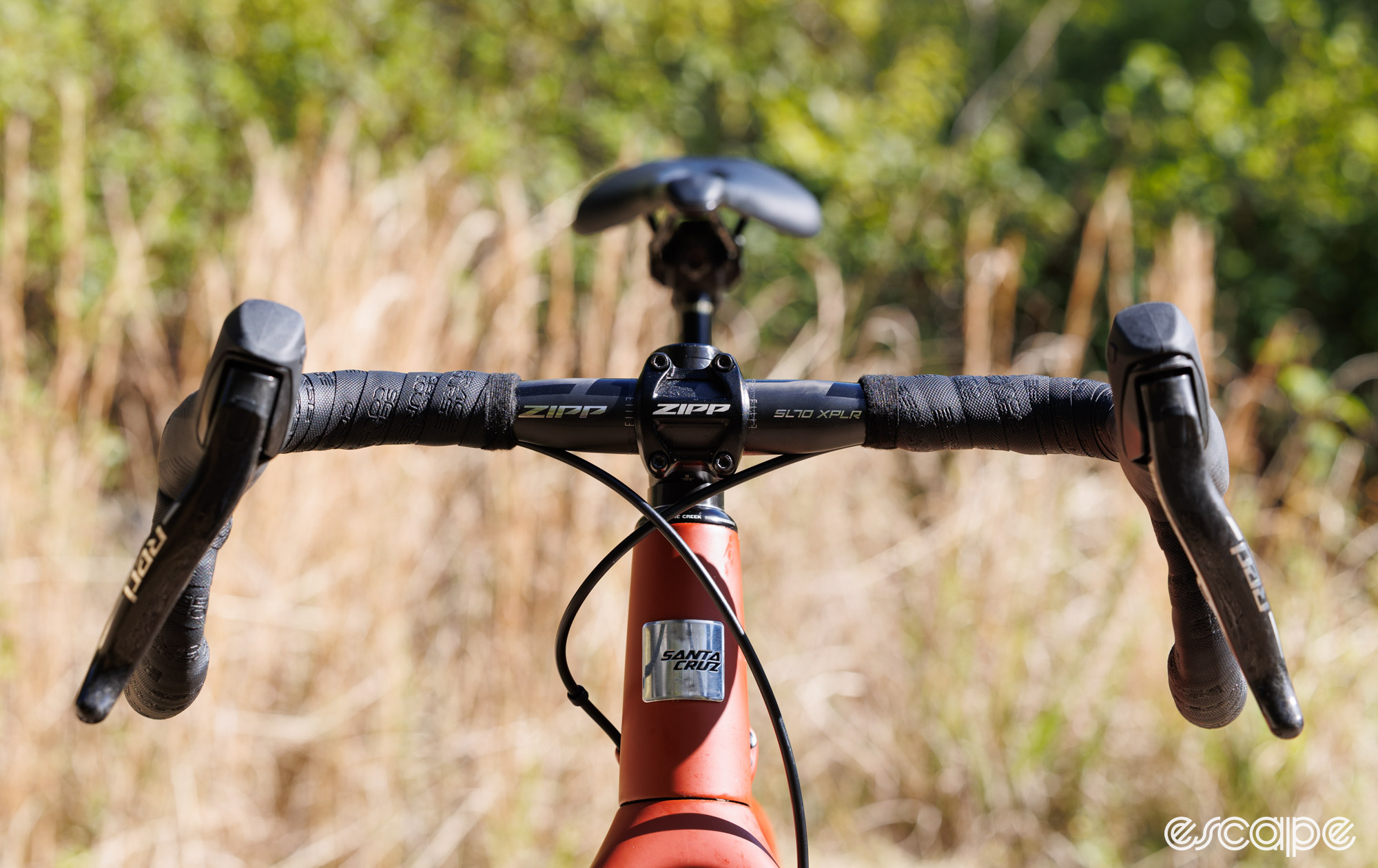

What did you think of this story?

